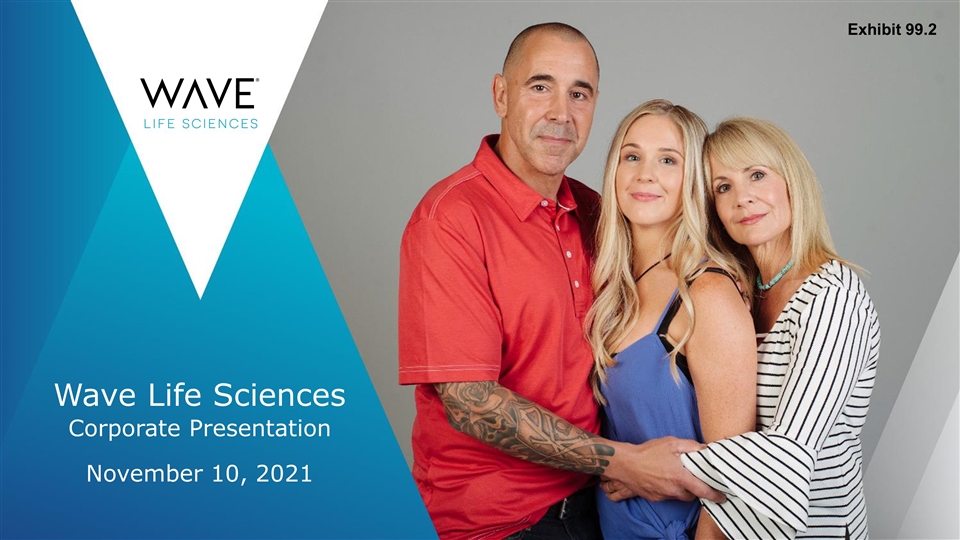
Wave Life Sciences Corporate Presentation November 10, 2021 Exhibit 99.2
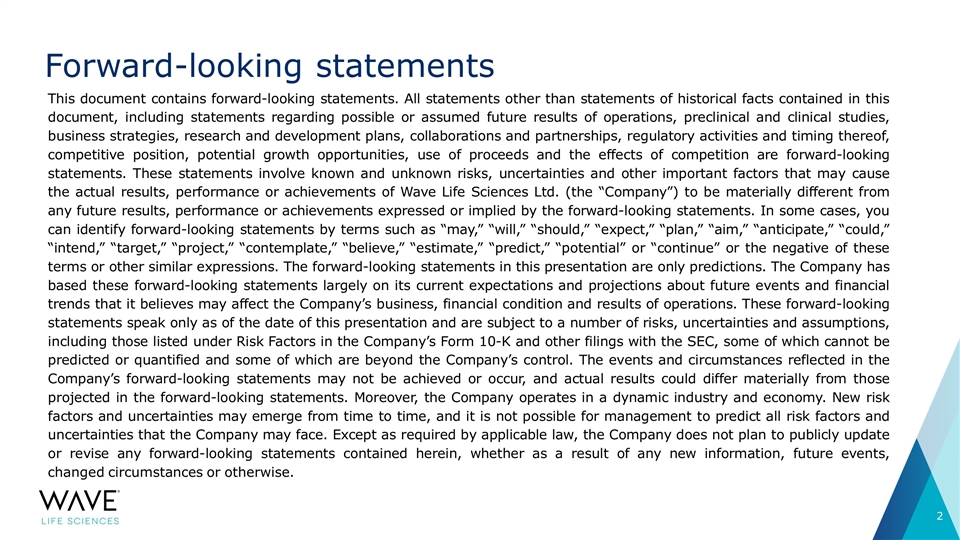
Forward-looking statements This document contains forward-looking statements. All statements other than statements of historical facts contained in this document, including statements regarding possible or assumed future results of operations, preclinical and clinical studies, business strategies, research and development plans, collaborations and partnerships, regulatory activities and timing thereof, competitive position, potential growth opportunities, use of proceeds and the effects of competition are forward-looking statements. These statements involve known and unknown risks, uncertainties and other important factors that may cause the actual results, performance or achievements of Wave Life Sciences Ltd. (the “Company”) to be materially different from any future results, performance or achievements expressed or implied by the forward-looking statements. In some cases, you can identify forward-looking statements by terms such as “may,” “will,” “should,” “expect,” “plan,” “aim,” “anticipate,” “could,” “intend,” “target,” “project,” “contemplate,” “believe,” “estimate,” “predict,” “potential” or “continue” or the negative of these terms or other similar expressions. The forward-looking statements in this presentation are only predictions. The Company has based these forward-looking statements largely on its current expectations and projections about future events and financial trends that it believes may affect the Company’s business, financial condition and results of operations. These forward-looking statements speak only as of the date of this presentation and are subject to a number of risks, uncertainties and assumptions, including those listed under Risk Factors in the Company’s Form 10-K and other filings with the SEC, some of which cannot be predicted or quantified and some of which are beyond the Company’s control. The events and circumstances reflected in the Company’s forward-looking statements may not be achieved or occur, and actual results could differ materially from those projected in the forward-looking statements. Moreover, the Company operates in a dynamic industry and economy. New risk factors and uncertainties may emerge from time to time, and it is not possible for management to predict all risk factors and uncertainties that the Company may face. Except as required by applicable law, the Company does not plan to publicly update or revise any forward-looking statements contained herein, whether as a result of any new information, future events, changed circumstances or otherwise.

UNLOCKING THE BODY’S OWN ABILITY TO TREAT GENETIC DISEASE realizing a brighter future for patients and families
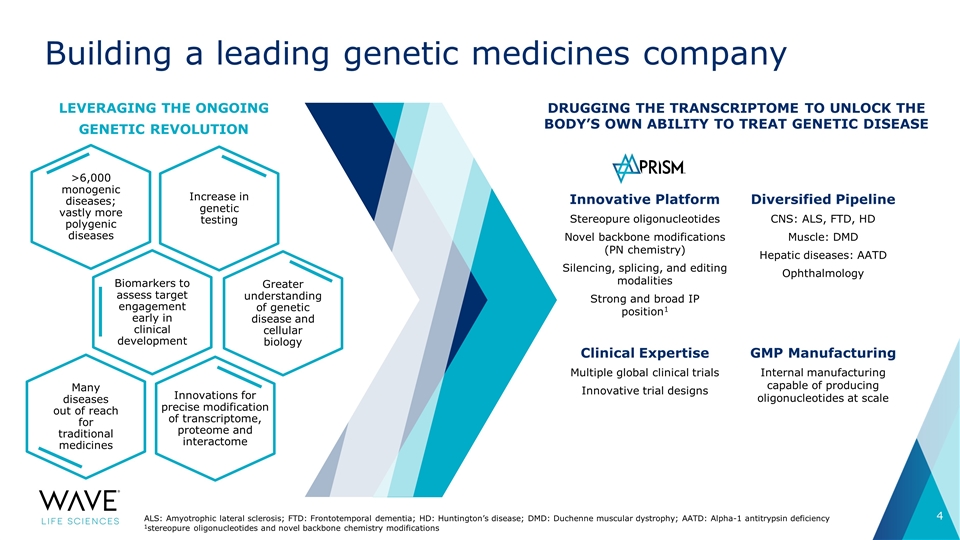
Building a leading genetic medicines company ALS: Amyotrophic lateral sclerosis; FTD: Frontotemporal dementia; HD: Huntington’s disease; DMD: Duchenne muscular dystrophy; AATD: Alpha-1 antitrypsin deficiency 1stereopure oligonucleotides and novel backbone chemistry modifications Diversified Pipeline CNS: ALS, FTD, HD Muscle: DMD Hepatic diseases: AATD Ophthalmology Clinical Expertise Multiple global clinical trials Innovative trial designs Innovative Platform Stereopure oligonucleotides Novel backbone modifications (PN chemistry) Silencing, splicing, and editing modalities Strong and broad IP position1 GMP Manufacturing Internal manufacturing capable of producing oligonucleotides at scale LEVERAGING THE ONGOING genetic revolution DRUGGING THE TRANSCRIPTOME TO UNLOCK THE BODY’S OWN ABILITY TO TREAT GENETIC DISEASE >6,000 monogenic diseases; vastly more polygenic diseases Increase in genetic testing Biomarkers to assess target engagement early in clinical development Greater understanding of genetic disease and cellular biology Many diseases out of reach for traditional medicines Innovations for precise modification of transcriptome, proteome and interactome
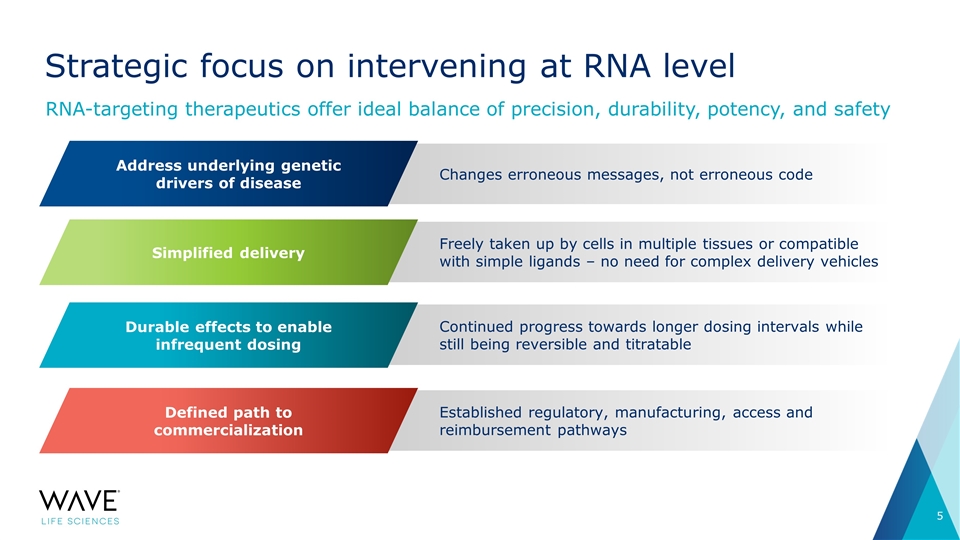
Established regulatory, manufacturing, access and reimbursement pathways Continued progress towards longer dosing intervals while still being reversible and titratable Freely taken up by cells in multiple tissues or compatible with simple ligands – no need for complex delivery vehicles Changes erroneous messages, not erroneous code Strategic focus on intervening at RNA level RNA-targeting therapeutics offer ideal balance of precision, durability, potency, and safety Address underlying genetic drivers of disease Durable effects to enable infrequent dosing Defined path to commercialization Simplified delivery
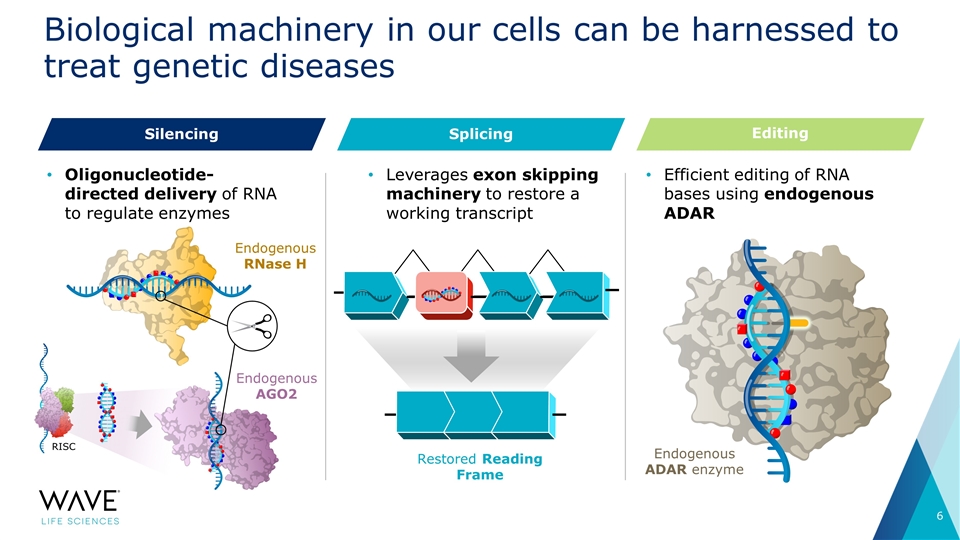
Biological machinery in our cells can be harnessed to treat genetic diseases Silencing Splicing Editing Oligonucleotide-directed delivery of RNA to regulate enzymes Leverages exon skipping machinery to restore a working transcript Efficient editing of RNA bases using endogenous ADAR Endogenous ADAR enzyme Restored Reading Frame Endogenous RNase H Endogenous AGO2 RISC
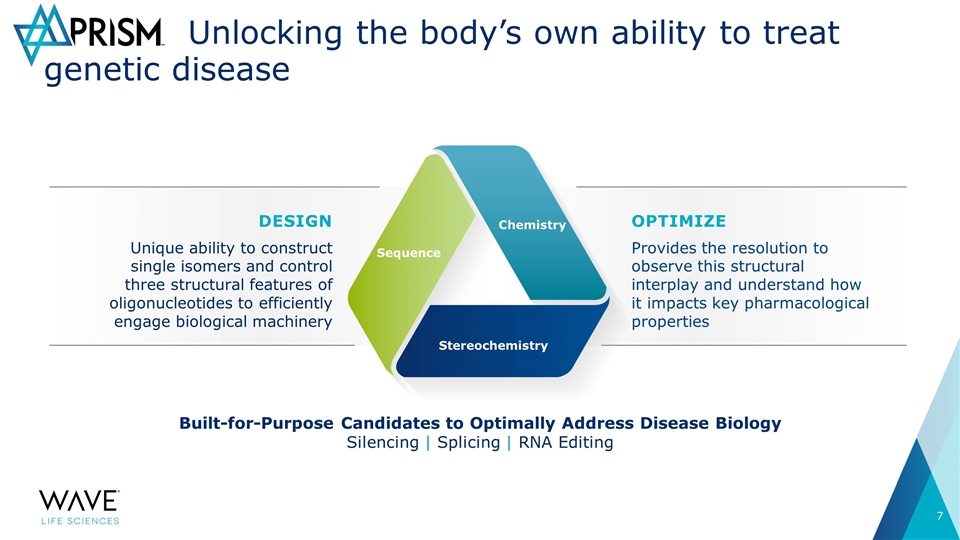
Built-for-Purpose Candidates to Optimally Address Disease Biology Silencing | Splicing | RNA Editing DESIGN Unique ability to construct single isomers and control three structural features of oligonucleotides to efficiently engage biological machinery OPTIMIZE Provides the resolution to observe this structural interplay and understand how it impacts key pharmacological properties Sequence Stereochemistry Chemistry Unlocking the body’s own ability to treat genetic disease
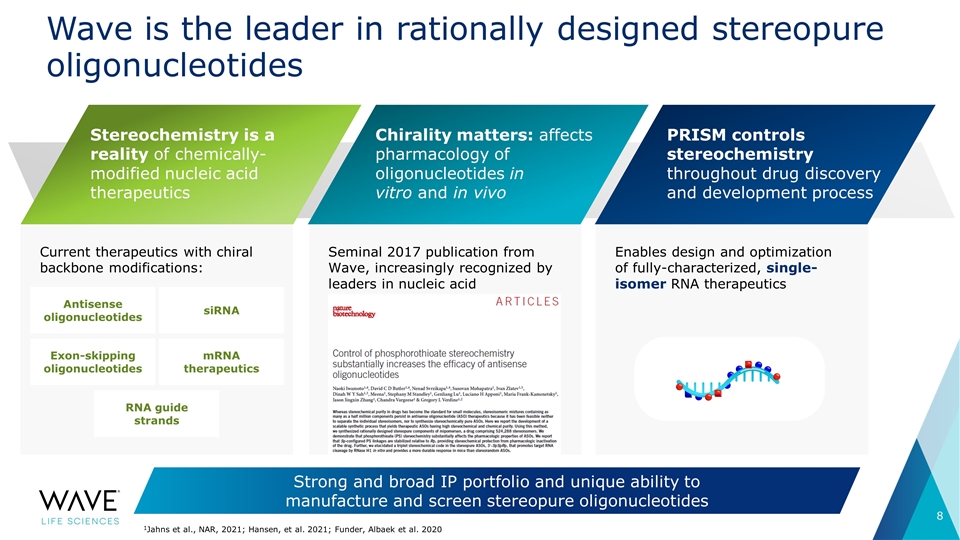
Seminal 2017 publication from Wave, increasingly recognized by leaders in nucleic acid therapeutics1 Current therapeutics with chiral backbone modifications: Enables design and optimization of fully-characterized, single-isomer RNA therapeutics Wave is the leader in rationally designed stereopure oligonucleotides Stereochemistry is a reality of chemically-modified nucleic acid therapeutics Strong and broad IP portfolio and unique ability to manufacture and screen stereopure oligonucleotides siRNA RNA guide strands mRNA therapeutics Antisense oligonucleotides Exon-skipping oligonucleotides PRISM controls stereochemistry throughout drug discovery and development process Chirality matters: affects pharmacology of oligonucleotides in vitro and in vivo 1Jahns et al., NAR, 2021; Hansen, et al. 2021; Funder, Albaek et al. 2020
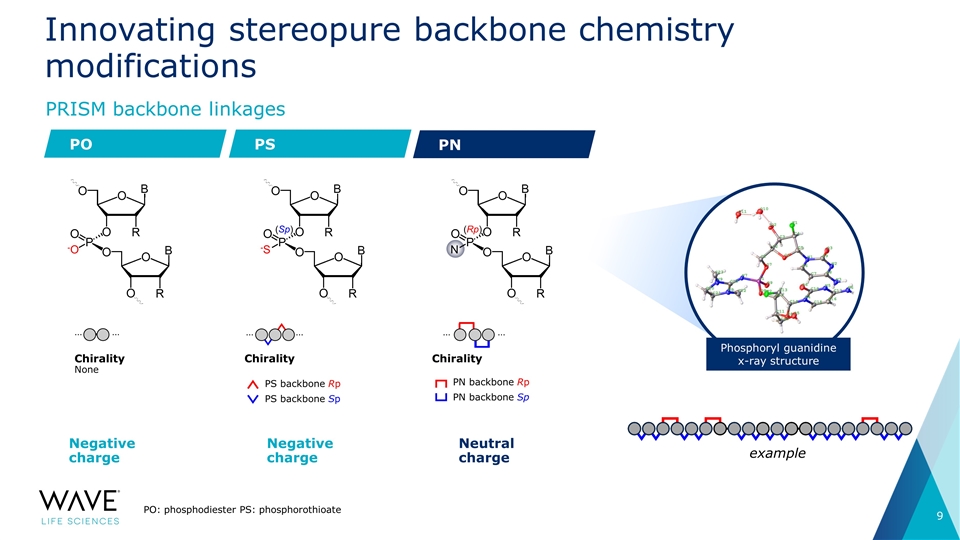
… … Innovating stereopure backbone chemistry modifications Chirality None PN backbone Sp PN backbone Rp Chirality … … PS backbone Rp PS backbone Sp Chirality … … PRISM backbone linkages PO: phosphodiester PS: phosphorothioate -O -S N (Rp) (Sp) PO PS PN Negative charge Neutral charge Negative charge Phosphoryl guanidine x-ray structure example
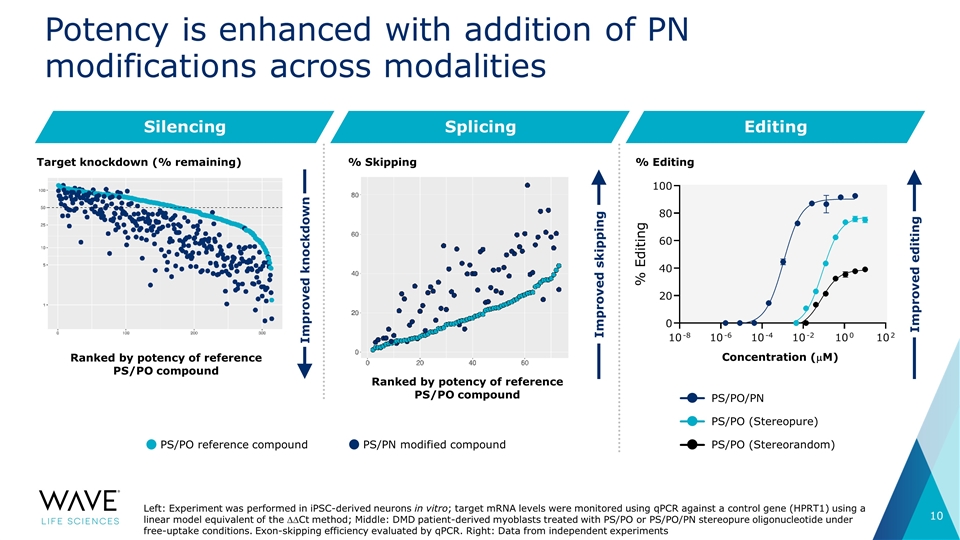
Silencing Potency is enhanced with addition of PN modifications across modalities Improved knockdown Splicing Editing Improved skipping Ranked by potency of reference PS/PO compound Ranked by potency of reference PS/PO compound Improved editing PS/PO/PN PS/PO (Stereopure) PS/PO (Stereorandom) Concentration (mM) % Editing PS/PO reference compound PS/PN modified compound % Skipping Target knockdown (% remaining) Left: Experiment was performed in iPSC-derived neurons in vitro; target mRNA levels were monitored using qPCR against a control gene (HPRT1) using a linear model equivalent of the DDCt method; Middle: DMD patient-derived myoblasts treated with PS/PO or PS/PO/PN stereopure oligonucleotide under free-uptake conditions. Exon-skipping efficiency evaluated by qPCR. Right: Data from independent experiments
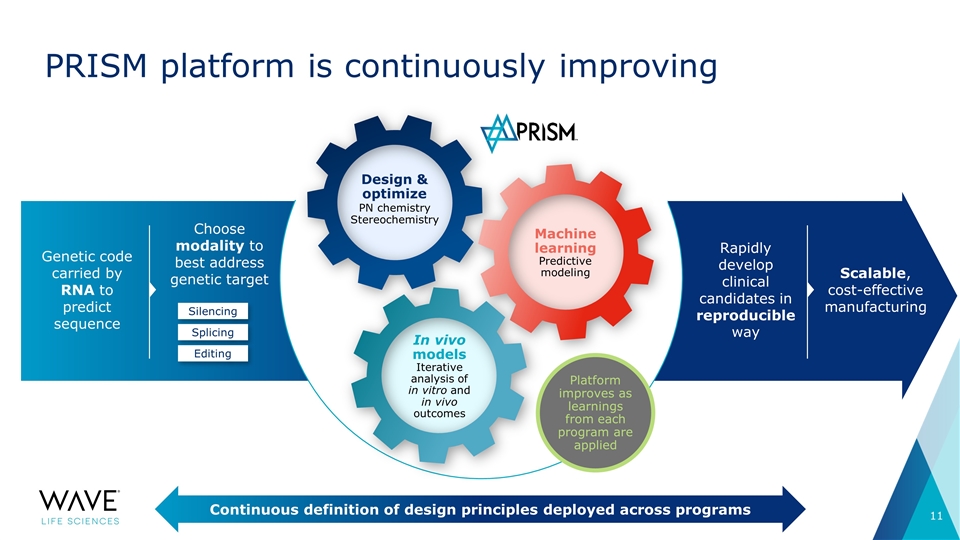
Choose modality to best address genetic target Rapidly develop clinical candidates in reproducible way Scalable, cost-effective manufacturing Genetic code carried by RNA to predict sequence PRISM platform is continuously improving Continuous definition of design principles deployed across programs Design & optimize PN chemistry Stereochemistry Machine learning Predictive modeling In vivo models Iterative analysis of in vitro and in vivo outcomes Platform improves as learnings from each program are applied Silencing Splicing Editing
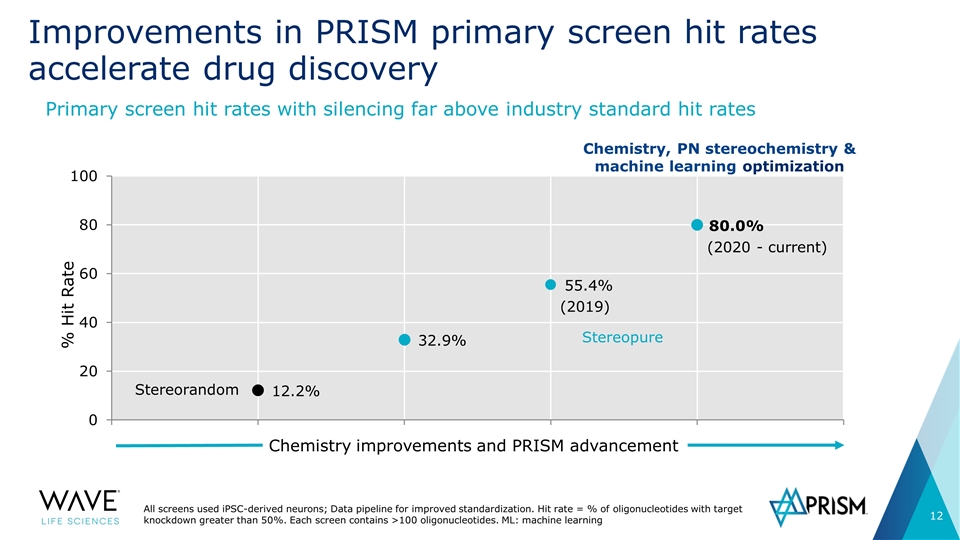
Improvements in PRISM primary screen hit rates accelerate drug discovery Primary screen hit rates with silencing far above industry standard hit rates Stereorandom Chemistry, PN stereochemistry & machine learning optimization Stereopure Chemistry improvements and PRISM advancement All screens used iPSC-derived neurons; Data pipeline for improved standardization. Hit rate = % of oligonucleotides with target knockdown greater than 50%. Each screen contains >100 oligonucleotides. ML: machine learning (2019) (2020 - current)
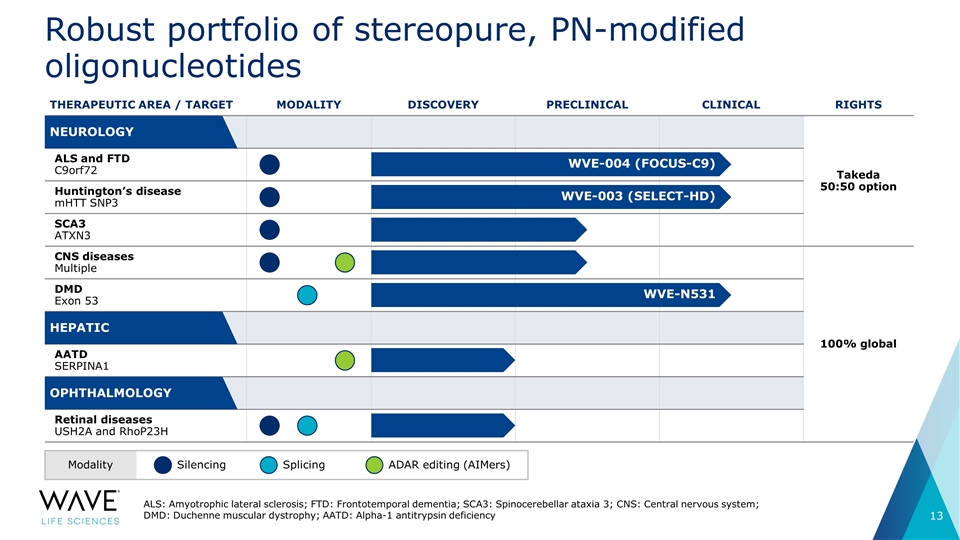
THERAPEUTIC AREA / TARGET MODALITY DISCOVERY PRECLINICAL CLINICAL RIGHTS NEUROLOGY Takeda 50:50 option ALS and FTD C9orf72 Takeda 50:50 option Huntington’s disease mHTT SNP3 SCA3 ATXN3 CNS diseases Multiple 100% global DMD Exon 53 100% global HEPATIC AATD SERPINA1 100% global OPHTHALMOLOGY Retinal diseases USH2A and RhoP23H 100% global Robust portfolio of stereopure, PN-modified oligonucleotides ALS: Amyotrophic lateral sclerosis; FTD: Frontotemporal dementia; SCA3: Spinocerebellar ataxia 3; CNS: Central nervous system; DMD: Duchenne muscular dystrophy; AATD: Alpha-1 antitrypsin deficiency Modality Silencing Splicing ADAR editing (AIMers) WVE-004 (FOCUS-C9) WVE-003 (SELECT-HD) WVE-N531 NEUROLOGY HEPATIC OPHTHALMOLOGY
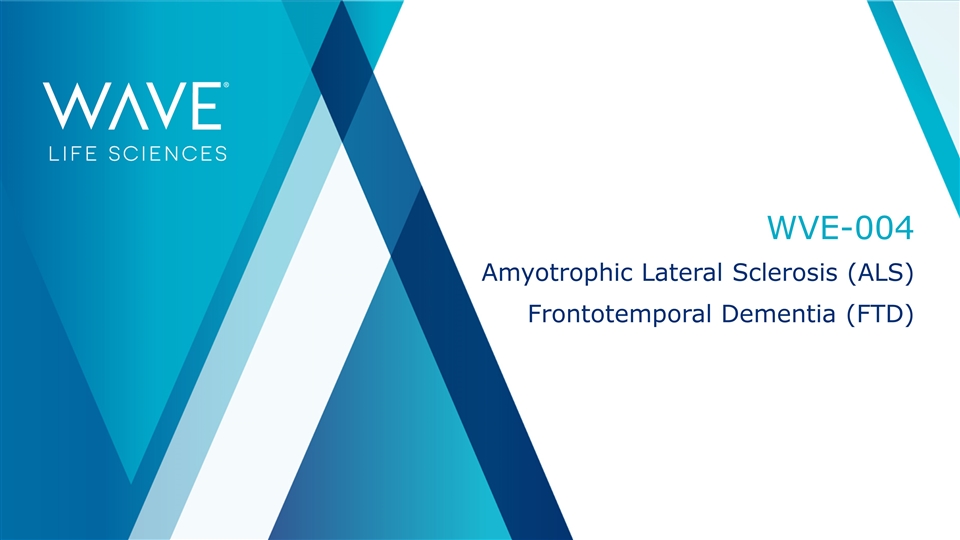
WVE-004 Amyotrophic Lateral Sclerosis (ALS) Frontotemporal Dementia (FTD)
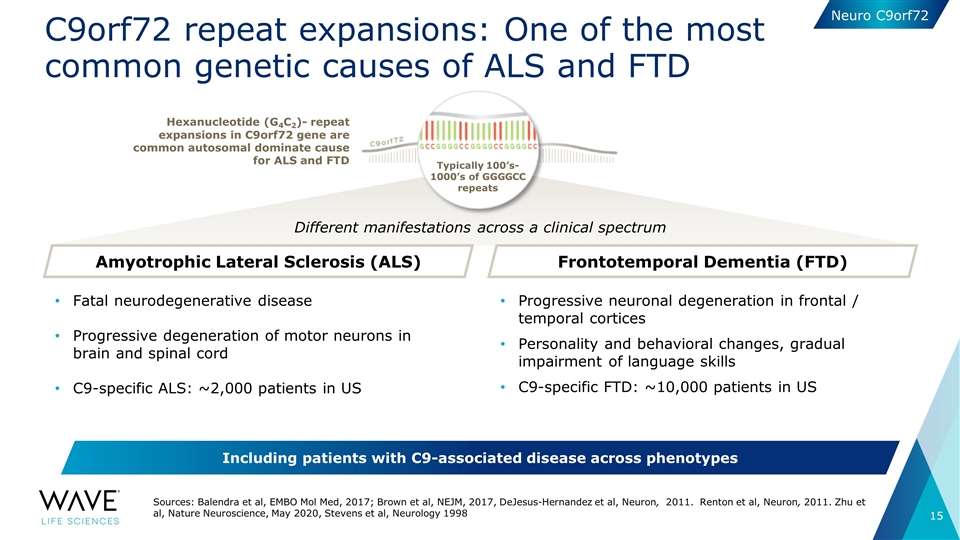
C9orf72 repeat expansions: One of the most common genetic causes of ALS and FTD Typically 100’s-1000’s of GGGGCC repeats Amyotrophic Lateral Sclerosis (ALS) Frontotemporal Dementia (FTD) Hexanucleotide (G4C2)- repeat expansions in C9orf72 gene are common autosomal dominate cause for ALS and FTD Different manifestations across a clinical spectrum Fatal neurodegenerative disease Progressive degeneration of motor neurons in brain and spinal cord C9-specific ALS: ~2,000 patients in US Progressive neuronal degeneration in frontal / temporal cortices Personality and behavioral changes, gradual impairment of language skills C9-specific FTD: ~10,000 patients in US Including patients with C9-associated disease across phenotypes Sources: Balendra et al, EMBO Mol Med, 2017; Brown et al, NEJM, 2017, DeJesus-Hernandez et al, Neuron, 2011. Renton et al, Neuron, 2011. Zhu et al, Nature Neuroscience, May 2020, Stevens et al, Neurology 1998 Neuro C9orf72
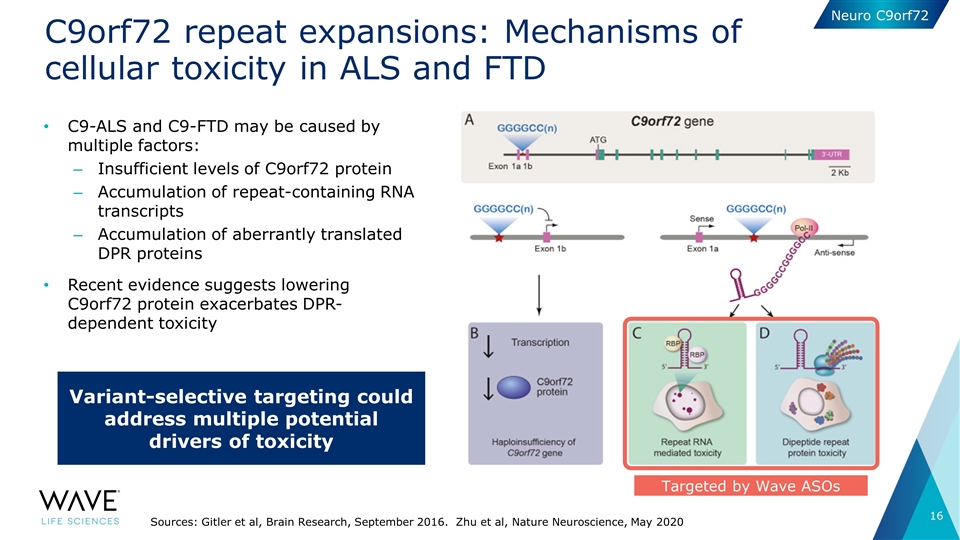
C9orf72 repeat expansions: Mechanisms of cellular toxicity in ALS and FTD C9-ALS and C9-FTD may be caused by multiple factors: Insufficient levels of C9orf72 protein Accumulation of repeat-containing RNA transcripts Accumulation of aberrantly translated DPR proteins Recent evidence suggests lowering C9orf72 protein exacerbates DPR-dependent toxicity Sources: Gitler et al, Brain Research, September 2016. Zhu et al, Nature Neuroscience, May 2020 Targeted by Wave ASOs Variant-selective targeting could address multiple potential drivers of toxicity Neuro C9orf72
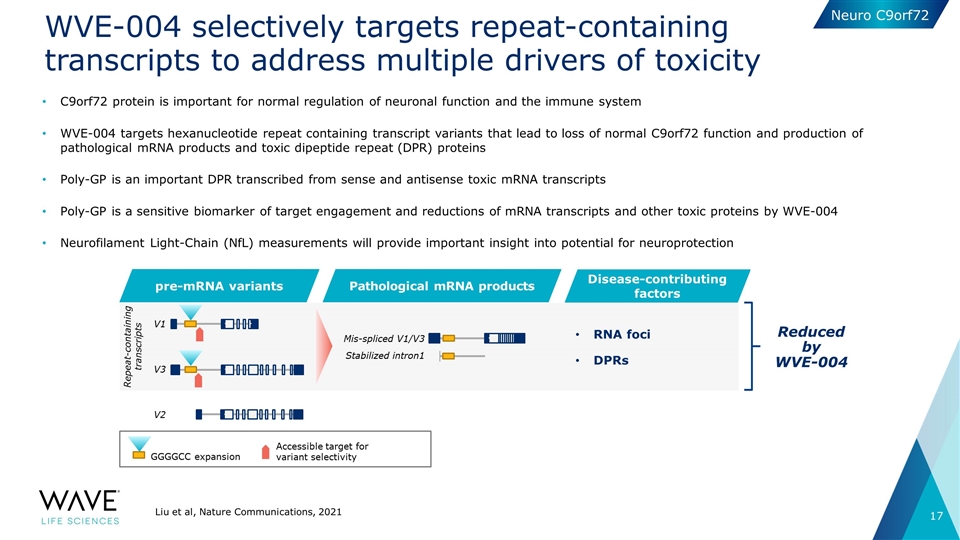
C9orf72 protein is important for normal regulation of neuronal function and the immune system WVE-004 targets hexanucleotide repeat containing transcript variants that lead to loss of normal C9orf72 function and production of pathological mRNA products and toxic dipeptide repeat (DPR) proteins Poly-GP is an important DPR transcribed from sense and antisense toxic mRNA transcripts Poly-GP is a sensitive biomarker of target engagement and reductions of mRNA transcripts and other toxic proteins by WVE-004 Neurofilament Light-Chain (NfL) measurements will provide important insight into potential for neuroprotection WVE-004 selectively targets repeat-containing transcripts to address multiple drivers of toxicity Liu et al, Nature Communications, 2021 pre-mRNA variants Pathological mRNA products V1 V2 Mis-spliced V1/V3 Stabilized intron1 V3 Disease-contributing factors RNA foci DPRs GGGGCC expansion Accessible target for variant selectivity Reduced by WVE-004 Repeat-containing transcripts Neuro C9orf72
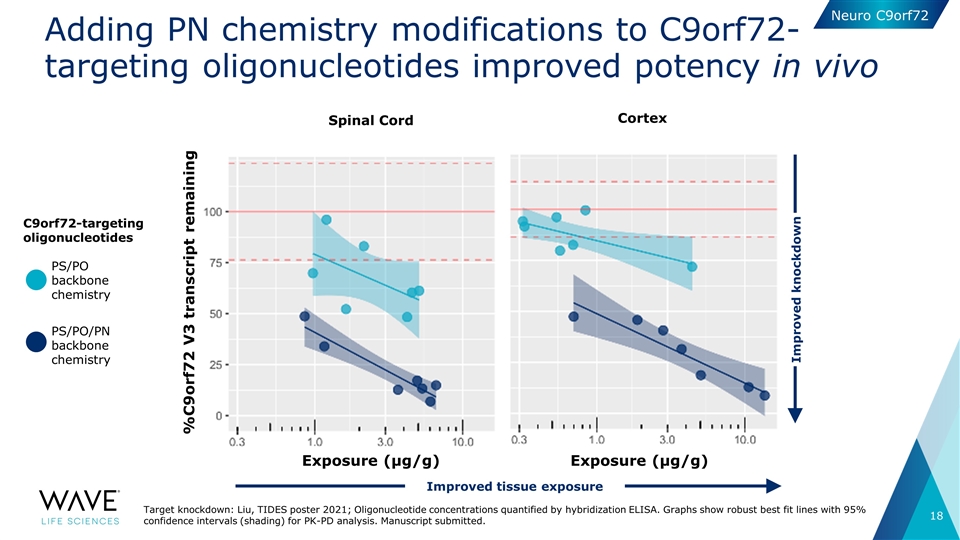
Adding PN chemistry modifications to C9orf72-targeting oligonucleotides improved potency in vivo Exposure (µg/g) Exposure (µg/g) Cortex %C9orf72 V3 transcript remaining Target knockdown: Liu, TIDES poster 2021; Oligonucleotide concentrations quantified by hybridization ELISA. Graphs show robust best fit lines with 95% confidence intervals (shading) for PK-PD analysis. Manuscript submitted. Spinal Cord C9orf72-targeting oligonucleotides PS/PO backbone chemistry PS/PO/PN backbone chemistry Improved knockdown Improved tissue exposure Neuro C9orf72
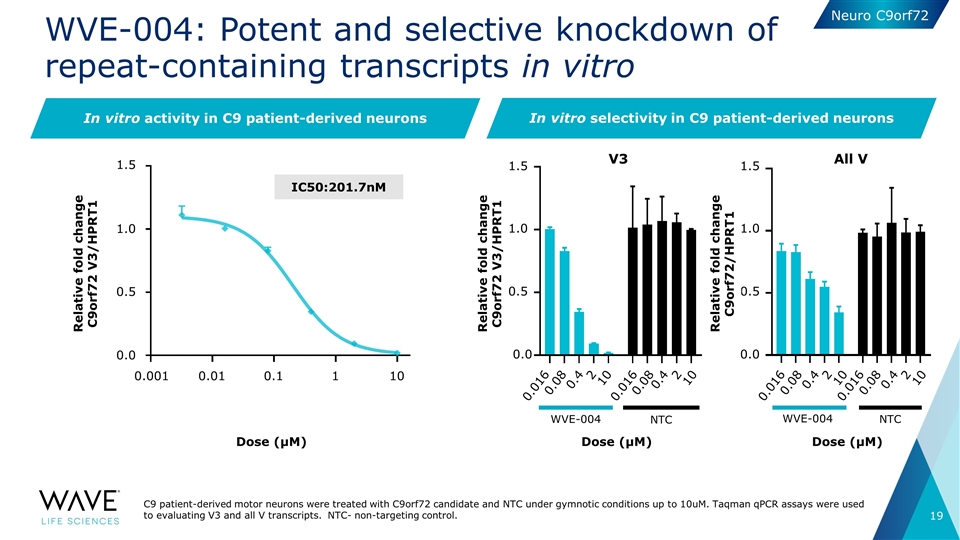
WVE-004: Potent and selective knockdown of repeat-containing transcripts in vitro V3 Dose (μM) All V WVE-004 NTC Dose (μM) In vitro activity in C9 patient-derived neurons WVE-004 NTC Dose (μM) IC50:201.7nM In vitro selectivity in C9 patient-derived neurons C9 patient-derived motor neurons were treated with C9orf72 candidate and NTC under gymnotic conditions up to 10uM. Taqman qPCR assays were used to evaluating V3 and all V transcripts. NTC- non-targeting control. Relative fold change C9orf72 V3/HPRT1 1.5 1.0 0.5 0.0 0.001 0.01 0.1 1 10 Relative fold change C9orf72 V3/HPRT1 0.016 0.08 0.4 2 10 0.016 0.08 0.4 2 10 0.016 0.08 0.4 2 10 0.016 0.08 0.4 2 10 1.5 1.0 0.5 0.0 1.5 1.0 0.5 0.0 Relative fold change C9orf72/HPRT1 Neuro C9orf72
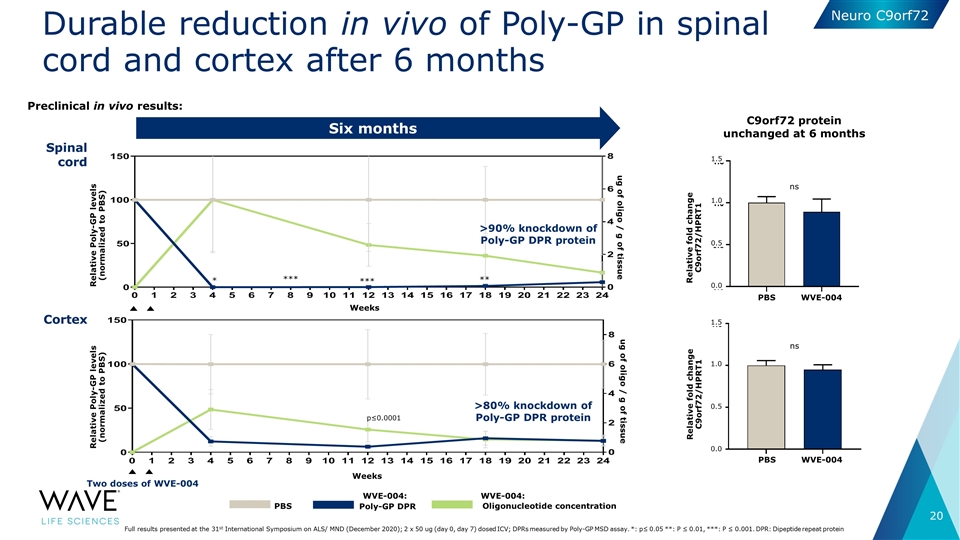
* *** ** *** Spinal cord Relative Poly-GP levels (normalized to PBS) Cortex >90% knockdown of Poly-GP DPR protein Two doses of WVE-004 Six months >80% knockdown of Poly-GP DPR protein Relative Poly-GP levels (normalized to PBS) p≤0.0001 Full results presented at the 31st International Symposium on ALS/ MND (December 2020); 2 x 50 ug (day 0, day 7) dosed ICV; DPRs measured by Poly-GP MSD assay. *: p≤ 0.05 **: P ≤ 0.01, ***: P ≤ 0.001. DPR: Dipeptide repeat protein Weeks Weeks PBS Poly-GP DPR Oligonucleotide concentration WVE-004: WVE-004: C9orf72 protein unchanged at 6 months ns ug of oligo / g of tissue ug of oligo / g of tissue ns Relative fold change C9orf72/HPRT1 1.5 0.5 0.0 1.0 Relative fold change C9orf72/HPRT1 1.5 0.5 0.0 1.0 WVE-004 PBS WVE-004 PBS Durable reduction in vivo of Poly-GP in spinal cord and cortex after 6 months Preclinical in vivo results: Neuro C9orf72
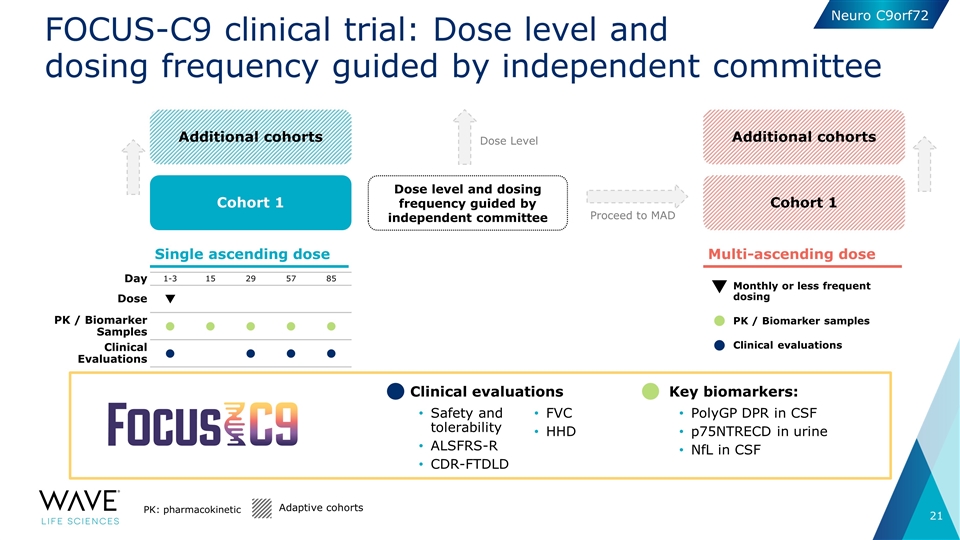
Day 1-3 15 29 57 85 Dose q PK / Biomarker Samples l l l l l Clinical Evaluations l l l l FOCUS-C9 clinical trial: Dose level and dosing frequency guided by independent committee Dose level and dosing frequency guided by independent committee Single ascending dose Dose Level Cohort 1 Cohort 1 Additional cohorts Proceed to MAD Monthly or less frequent dosing PK / Biomarker samples Clinical evaluations Additional cohorts l l q Safety and tolerability ALSFRS-R CDR-FTDLD FVC HHD Clinical evaluations PolyGP DPR in CSF p75NTRECD in urine NfL in CSF Key biomarkers: PK: pharmacokinetic Multi-ascending dose Adaptive cohorts Neuro C9orf72

WVE-003 Huntington’s Disease
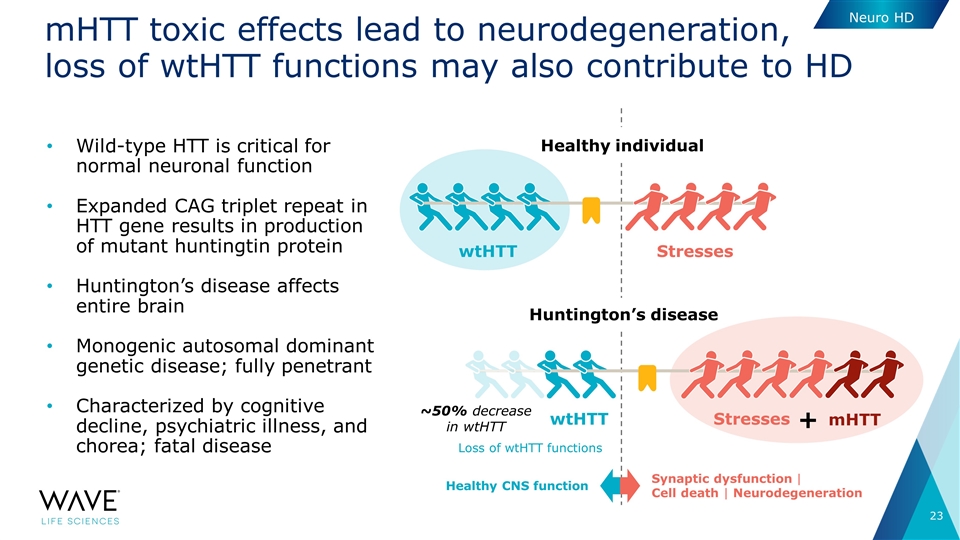
Healthy individual Huntington’s disease mHTT toxic effects lead to neurodegeneration, loss of wtHTT functions may also contribute to HD Wild-type HTT is critical for normal neuronal function Expanded CAG triplet repeat in HTT gene results in production of mutant huntingtin protein Huntington’s disease affects entire brain Monogenic autosomal dominant genetic disease; fully penetrant Characterized by cognitive decline, psychiatric illness, and chorea; fatal disease Stresses wtHTT Stresses wtHTT mHTT + ~50% decrease in wtHTT Healthy CNS function Synaptic dysfunction | Cell death | Neurodegeneration Loss of wtHTT functions Neuro HD
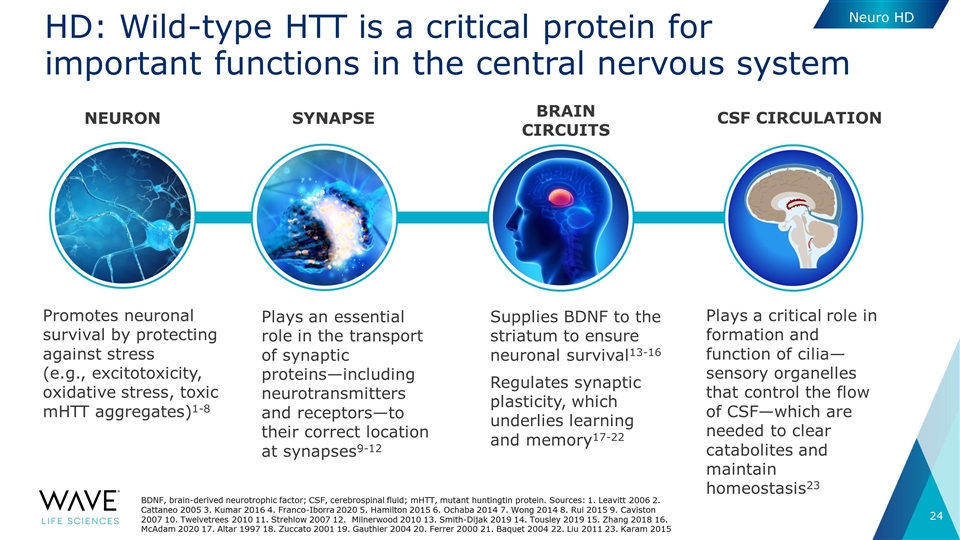
Plays an essential role in the transport of synaptic proteins—including neurotransmitters and receptors—to their correct location at synapses9-12 Promotes neuronal survival by protecting against stress (e.g., excitotoxicity, oxidative stress, toxic mHTT aggregates)1-8 BRAIN CIRCUITS SYNAPSE NEURON CSF circulation Supplies BDNF to the striatum to ensure neuronal survival13-16 Regulates synaptic plasticity, which underlies learning and memory17-22 Plays a critical role in formation and function of cilia—sensory organelles that control the flow of CSF—which are needed to clear catabolites and maintain homeostasis23 HD: Wild-type HTT is a critical protein for important functions in the central nervous system BDNF, brain-derived neurotrophic factor; CSF, cerebrospinal fluid; mHTT, mutant huntingtin protein. Sources: 1. Leavitt 2006 2. Cattaneo 2005 3. Kumar 2016 4. Franco-Iborra 2020 5. Hamilton 2015 6. Ochaba 2014 7. Wong 2014 8. Rui 2015 9. Caviston 2007 10. Twelvetrees 2010 11. Strehlow 2007 12. Milnerwood 2010 13. Smith-Dijak 2019 14. Tousley 2019 15. Zhang 2018 16. McAdam 2020 17. Altar 1997 18. Zuccato 2001 19. Gauthier 2004 20. Ferrer 2000 21. Baquet 2004 22. Liu 2011 23. Karam 2015 Neuro HD
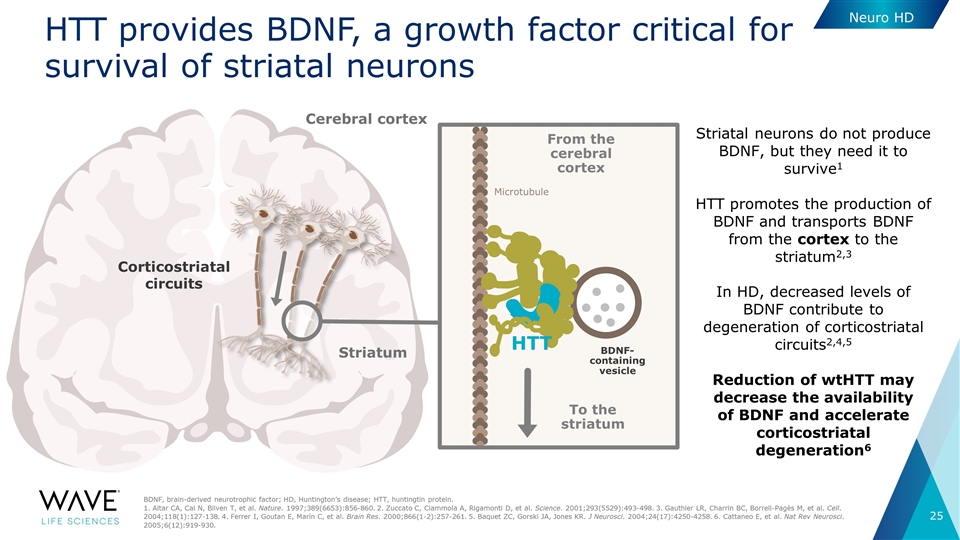
Cerebral cortex Striatum BDNF- containing vesicle To the striatum Microtubule HTT HTT provides BDNF, a growth factor critical for survival of striatal neurons BDNF, brain-derived neurotrophic factor; HD, Huntington’s disease; HTT, huntingtin protein. 1. Altar CA, Cai N, Bliven T, et al. Nature. 1997;389(6653):856-860. 2. Zuccato C, Ciammola A, Rigamonti D, et al. Science. 2001;293(5529):493-498. 3. Gauthier LR, Charrin BC, Borrell-Pagès M, et al. Cell. 2004;118(1):127-138. 4. Ferrer I, Goutan E, Marín C, et al. Brain Res. 2000;866(1-2):257-261. 5. Baquet ZC, Gorski JA, Jones KR. J Neurosci. 2004;24(17):4250-4258. 6. Cattaneo E, et al. Nat Rev Neurosci. 2005;6(12):919-930. From the cerebral cortex Striatal neurons do not produce BDNF, but they need it to survive1 HTT promotes the production of BDNF and transports BDNF from the cortex to the striatum2,3 In HD, decreased levels of BDNF contribute to degeneration of corticostriatal circuits2,4,5 Reduction of wtHTT may decrease the availability of BDNF and accelerate corticostriatal degeneration6 Corticostriatal circuits Neuro HD
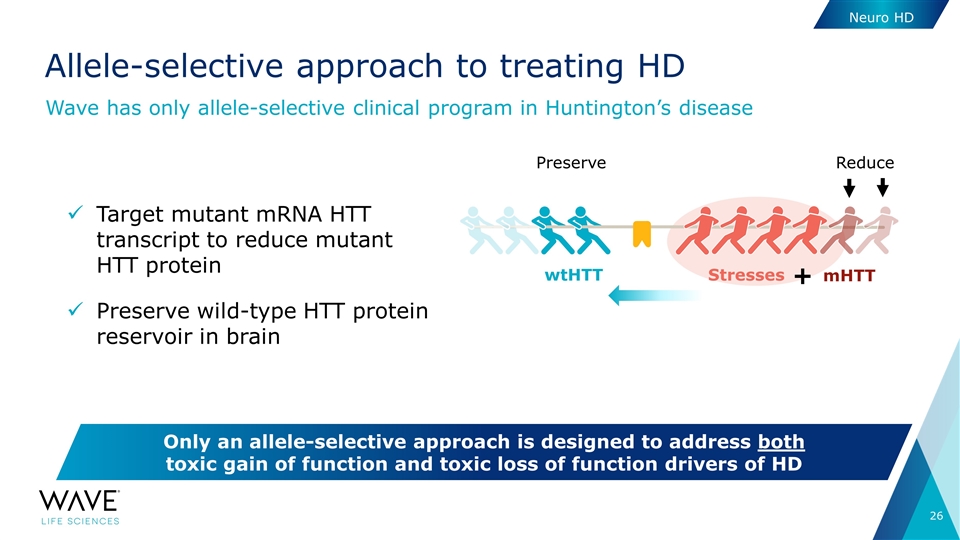
Target mutant mRNA HTT transcript to reduce mutant HTT protein Preserve wild-type HTT protein reservoir in brain Allele-selective approach to treating HD Wave has only allele-selective clinical program in Huntington’s disease Only an allele-selective approach is designed to address both toxic gain of function and toxic loss of function drivers of HD Stresses wtHTT mHTT + Reduce Preserve Neuro HD
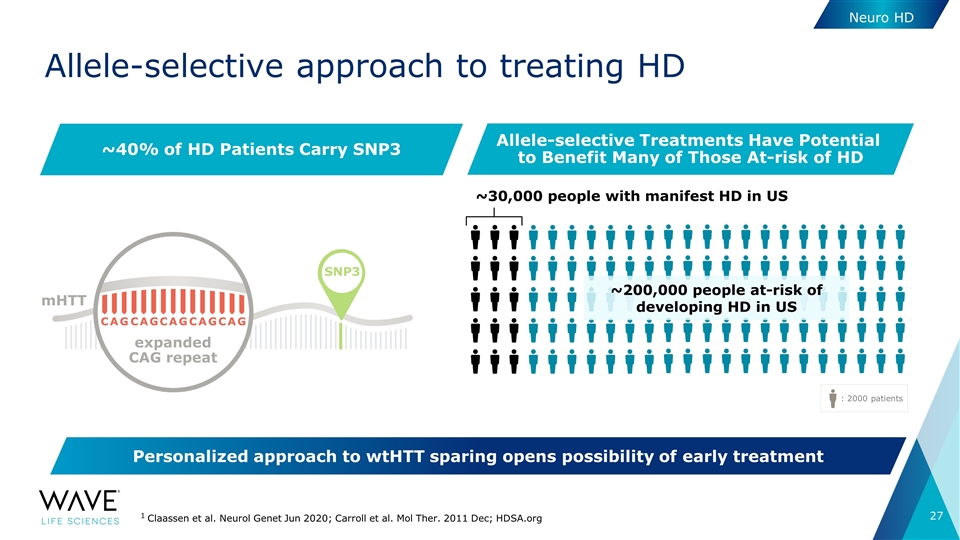
Allele-selective approach to treating HD Neuro HD 1 Claassen et al. Neurol Genet Jun 2020; Carroll et al. Mol Ther. 2011 Dec; HDSA.org : 2000 patients ~30,000 people with manifest HD in US ~40% of HD Patients Carry SNP3 Allele-selective Treatments Have Potential to Benefit Many of Those At-risk of HD ~200,000 people at-risk of developing HD in US SNP3 C A G C A G C A G C A G C A G expanded CAG repeat mHTT Personalized approach to wtHTT sparing opens possibility of early treatment
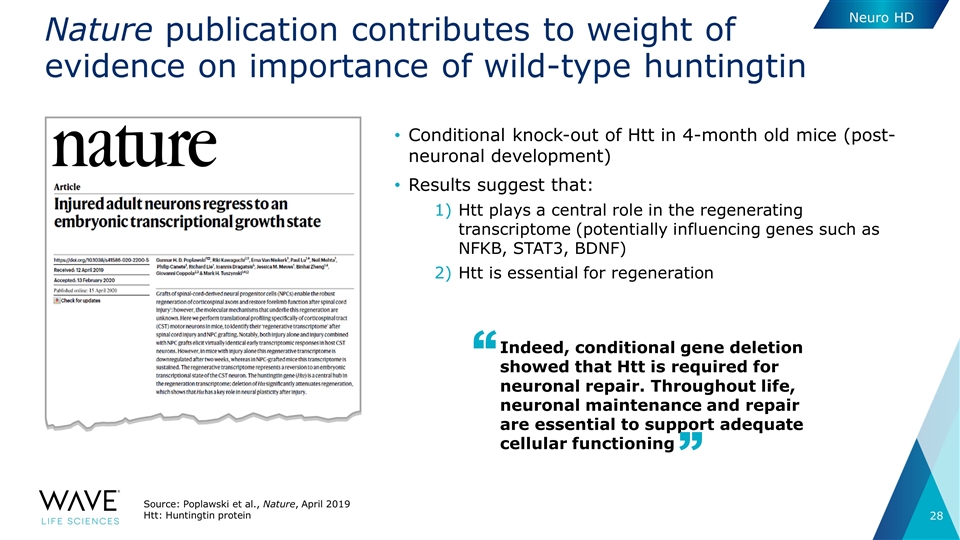
Nature publication contributes to weight of evidence on importance of wild-type huntingtin Source: Poplawski et al., Nature, April 2019 Htt: Huntingtin protein Conditional knock-out of Htt in 4-month old mice (post-neuronal development) Results suggest that: Htt plays a central role in the regenerating transcriptome (potentially influencing genes such as NFKB, STAT3, BDNF) Htt is essential for regeneration Indeed, conditional gene deletion showed that Htt is required for neuronal repair. Throughout life, neuronal maintenance and repair are essential to support adequate cellular functioning Neuro HD
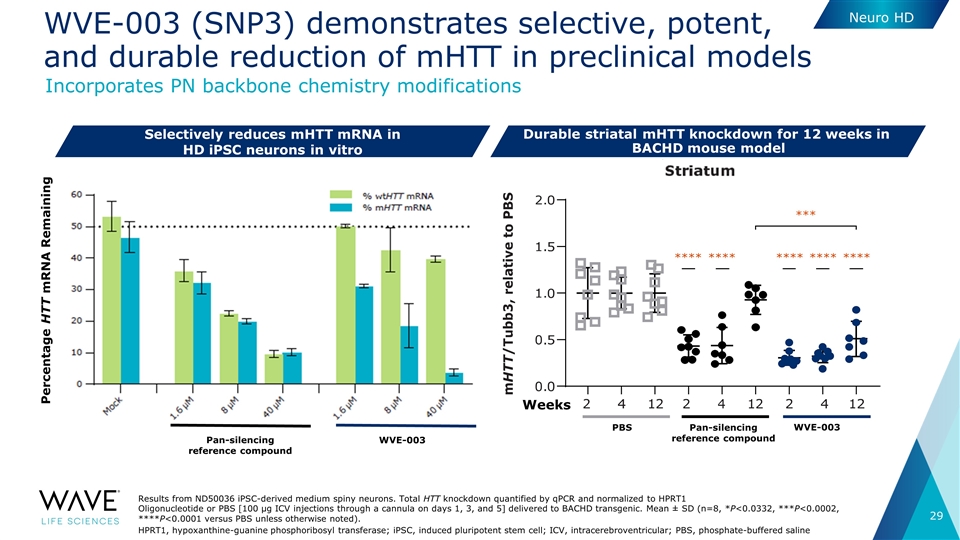
WVE-003 (SNP3) demonstrates selective, potent, and durable reduction of mHTT in preclinical models Selectively reduces mHTT mRNA in HD iPSC neurons in vitro Results from ND50036 iPSC-derived medium spiny neurons. Total HTT knockdown quantified by qPCR and normalized to HPRT1 Oligonucleotide or PBS [100 μg ICV injections through a cannula on days 1, 3, and 5] delivered to BACHD transgenic. Mean ± SD (n=8, *P<0.0332, ***P<0.0002, ****P<0.0001 versus PBS unless otherwise noted). HPRT1, hypoxanthine-guanine phosphoribosyl transferase; iPSC, induced pluripotent stem cell; ICV, intracerebroventricular; PBS, phosphate-buffered saline Similar results in cortex Pan-silencing reference compound WVE-003 PBS Weeks *** **** **** **** **** **** Pan-silencing reference compound WVE-003 Percentage HTT mRNA Remaining Durable striatal mHTT knockdown for 12 weeks in BACHD mouse model Neuro HD Incorporates PN backbone chemistry modifications
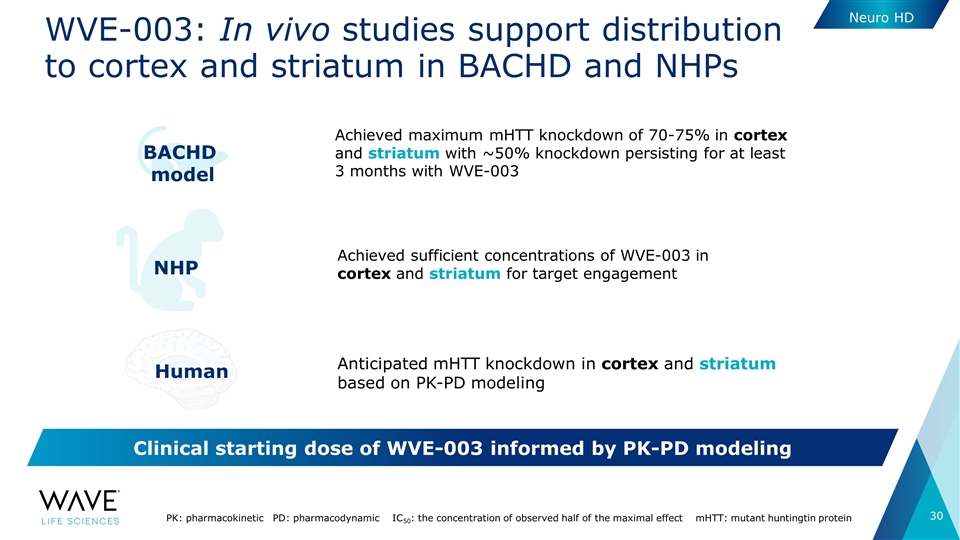
WVE-003: In vivo studies support distribution to cortex and striatum in BACHD and NHPs PK: pharmacokinetic PD: pharmacodynamic IC50: the concentration of observed half of the maximal effect mHTT: mutant huntingtin protein Achieved sufficient concentrations of WVE-003 in cortex and striatum for target engagement NHP Anticipated mHTT knockdown in cortex and striatum based on PK-PD modeling Human BACHD model Achieved maximum mHTT knockdown of 70-75% in cortex and striatum with ~50% knockdown persisting for at least 3 months with WVE-003 Clinical starting dose of WVE-003 informed by PK-PD modeling Neuro HD
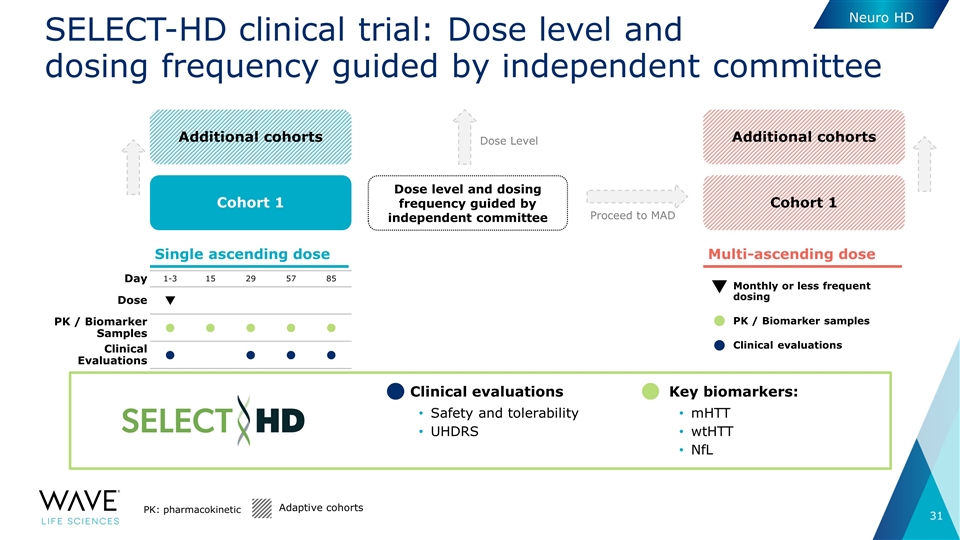
Day 1-3 15 29 57 85 Dose q PK / Biomarker Samples l l l l l Clinical Evaluations l l l l SELECT-HD clinical trial: Dose level and dosing frequency guided by independent committee Dose level and dosing frequency guided by independent committee Single ascending dose Dose Level Cohort 1 Cohort 1 Additional cohorts Proceed to MAD Monthly or less frequent dosing PK / Biomarker samples Clinical evaluations Additional cohorts l l q Safety and tolerability UHDRS Clinical evaluations mHTT wtHTT NfL Key biomarkers: PK: pharmacokinetic Multi-ascending dose Adaptive cohorts Neuro HD
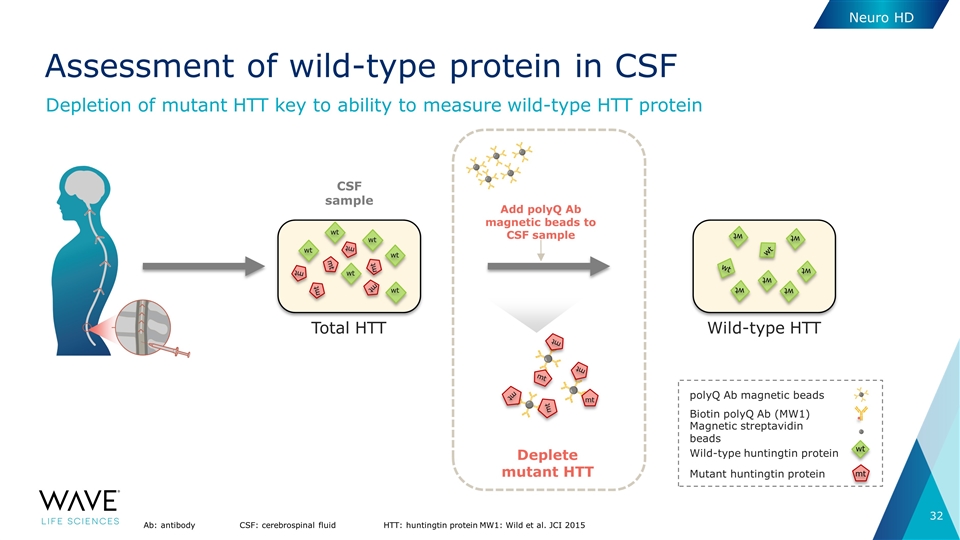
Neuro HD Assessment of wild-type protein in CSF Ab: antibodyCSF: cerebrospinal fluidHTT: huntingtin proteinMW1: Wild et al. JCI 2015 CSF sample Total HTT mt wt wt wt mt mt mt mt mt wt wt wt Wild-type HTT wt wt wt wt wt wt wt wt Deplete mutant HTT Add polyQ Ab magnetic beads to CSF sample mt mt mt mt mt mt polyQ Ab magnetic beads Biotin polyQ Ab (MW1) Magnetic streptavidin beads Wild-type huntingtin protein Mutant huntingtin protein wt mt Depletion of mutant HTT key to ability to measure wild-type HTT protein
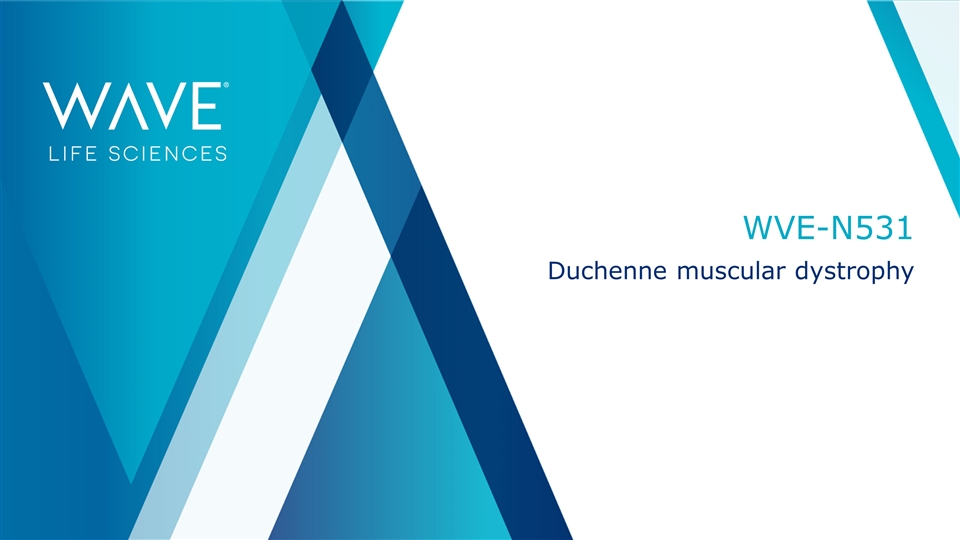
WVE-N531 Duchenne muscular dystrophy
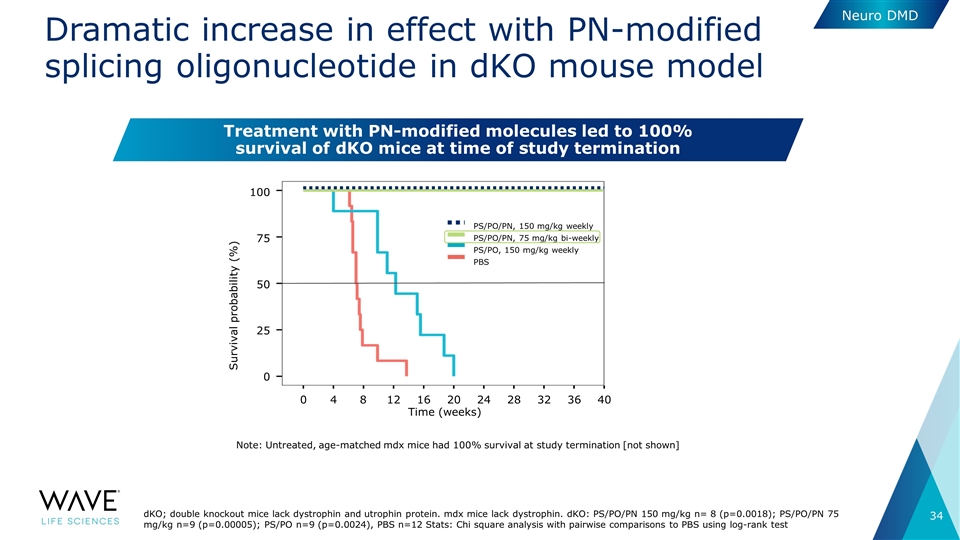
100 75 50 25 0 Survival probability (%) 0 4 8 12 16 20 24 28 32 36 40 Time (weeks) Dramatic increase in effect with PN-modified splicing oligonucleotide in dKO mouse model dKO; double knockout mice lack dystrophin and utrophin protein. mdx mice lack dystrophin. dKO: PS/PO/PN 150 mg/kg n= 8 (p=0.0018); PS/PO/PN 75 mg/kg n=9 (p=0.00005); PS/PO n=9 (p=0.0024), PBS n=12 Stats: Chi square analysis with pairwise comparisons to PBS using log-rank test PS/PO/PN, 75 mg/kg bi-weekly PBS PS/PO, 150 mg/kg weekly PS/PO/PN, 150 mg/kg weekly Note: Untreated, age-matched mdx mice had 100% survival at study termination [not shown] Treatment with PN-modified molecules led to 100% survival of dKO mice at time of study termination Neuro DMD
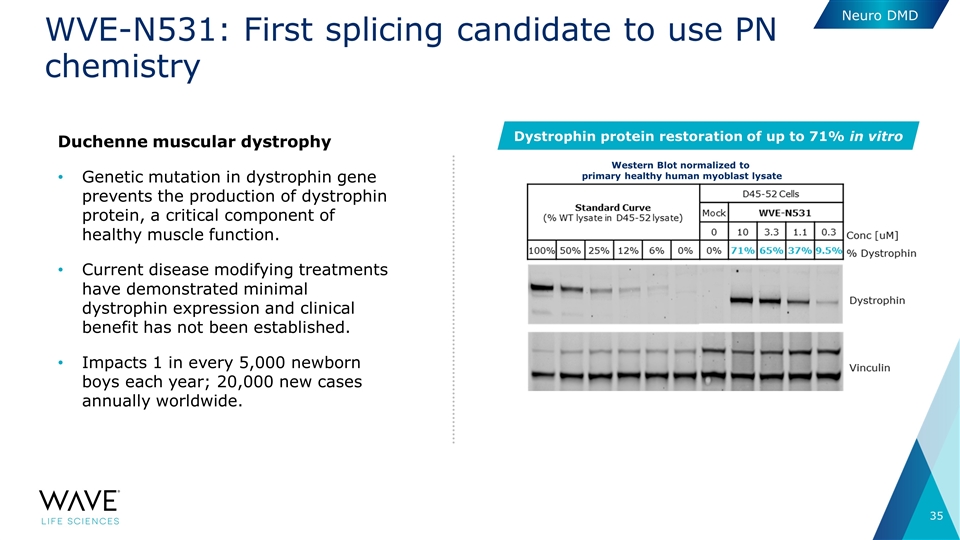
WVE-N531: First splicing candidate to use PN chemistry Duchenne muscular dystrophy Genetic mutation in dystrophin gene prevents the production of dystrophin protein, a critical component of healthy muscle function. Current disease modifying treatments have demonstrated minimal dystrophin expression and clinical benefit has not been established. Impacts 1 in every 5,000 newborn boys each year; 20,000 new cases annually worldwide. Western Blot normalized to primary healthy human myoblast lysate Dystrophin protein restoration of up to 71% in vitro Neuro DMD
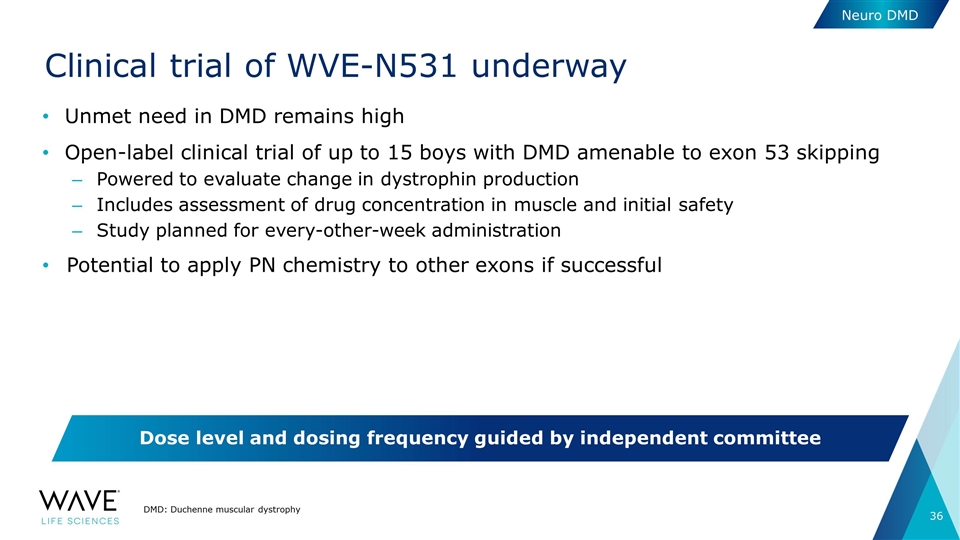
Clinical trial of WVE-N531 underway Unmet need in DMD remains high Open-label clinical trial of up to 15 boys with DMD amenable to exon 53 skipping Powered to evaluate change in dystrophin production Includes assessment of drug concentration in muscle and initial safety Study planned for every-other-week administration Potential to apply PN chemistry to other exons if successful Dose level and dosing frequency guided by independent committee DMD: Duchenne muscular dystrophy Neuro DMD
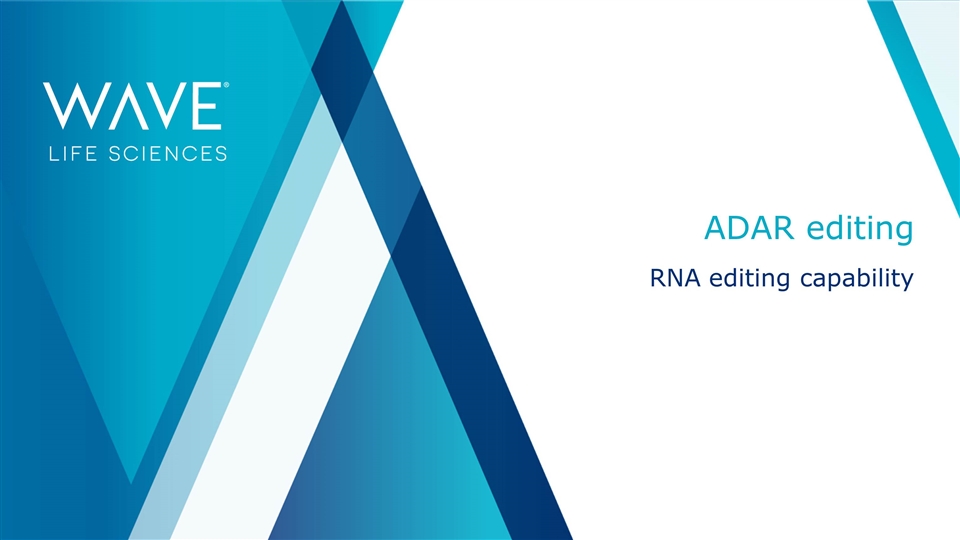
ADAR editing RNA editing capability
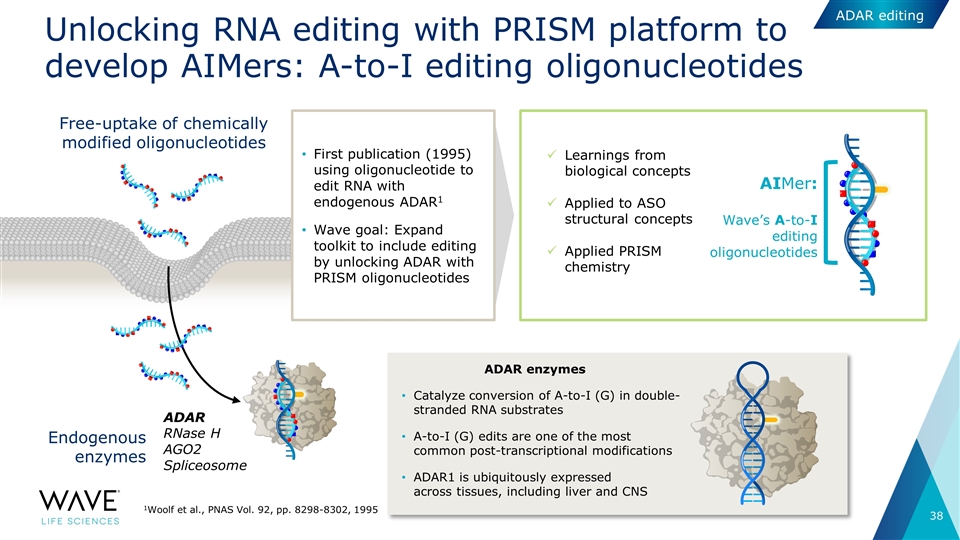
Unlocking RNA editing with PRISM platform to develop AIMers: A-to-I editing oligonucleotides ADAR enzymes Catalyze conversion of A-to-I (G) in double-stranded RNA substrates A-to-I (G) edits are one of the most common post-transcriptional modifications ADAR1 is ubiquitously expressed across tissues, including liver and CNS Endogenous enzymes Free-uptake of chemically modified oligonucleotides First publication (1995) using oligonucleotide to edit RNA with endogenous ADAR1 Wave goal: Expand toolkit to include editing by unlocking ADAR with PRISM oligonucleotides AIMer: Wave’s A-to-I editing oligonucleotides ADAR RNase H AGO2 Spliceosome Learnings from biological concepts Applied to ASO structural concepts Applied PRISM chemistry 1Woolf et al., PNAS Vol. 92, pp. 8298-8302, 1995 ADAR editing
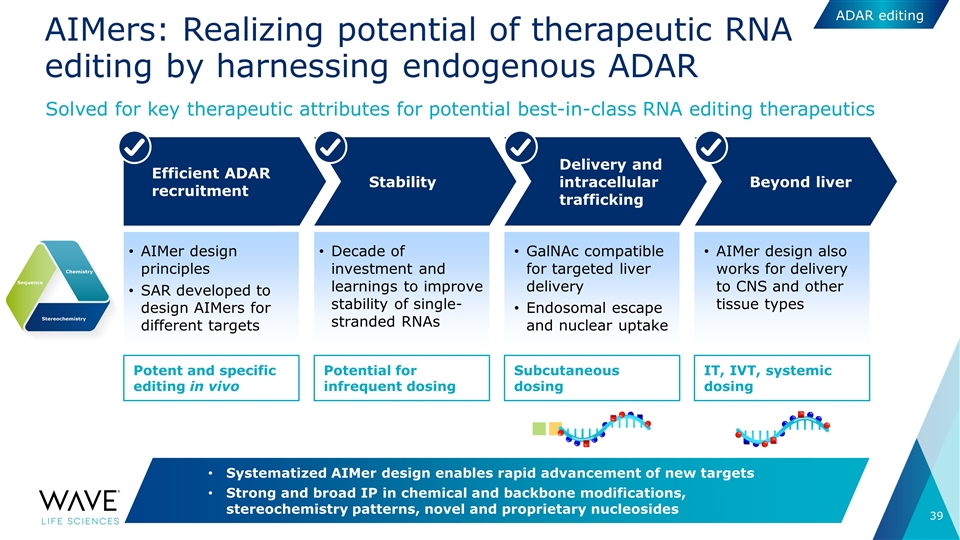
AIMers: Realizing potential of therapeutic RNA editing by harnessing endogenous ADAR Solved for key therapeutic attributes for potential best-in-class RNA editing therapeutics Efficient ADAR recruitment AIMer design principles SAR developed to design AIMers for different targets Systematized AIMer design enables rapid advancement of new targets Strong and broad IP in chemical and backbone modifications, stereochemistry patterns, novel and proprietary nucleosides Potent and specific editing in vivo Efficient ADAR recruitment Stability Delivery and intracellular trafficking Beyond liver Decade of investment and learnings to improve stability of single-stranded RNAs GalNAc compatible for targeted liver delivery Endosomal escape and nuclear uptake AIMer design also works for delivery to CNS and other tissue types Potential for infrequent dosing Subcutaneous dosing IT, IVT, systemic dosing ADAR editing
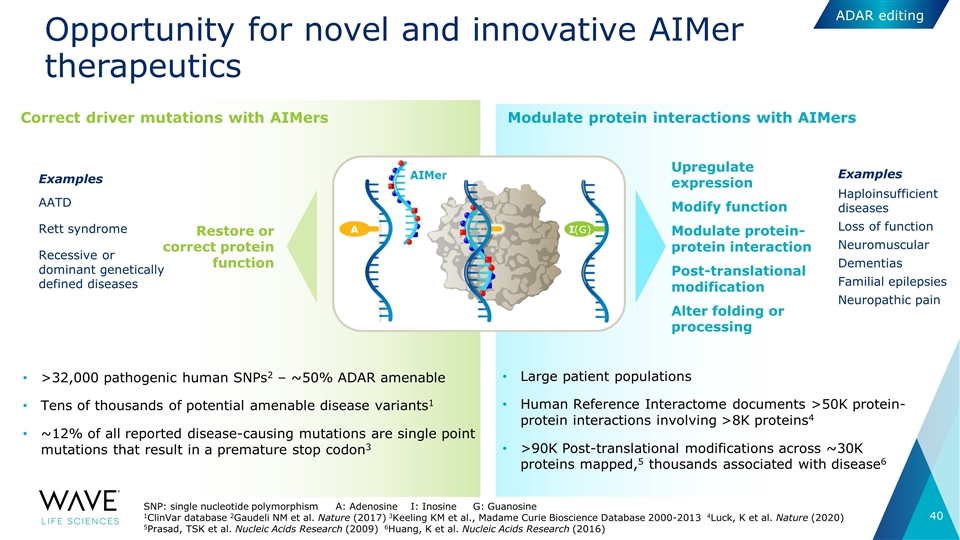
Opportunity for novel and innovative AIMer therapeutics SNP: single nucleotide polymorphism A: Adenosine I: Inosine G: Guanosine 1ClinVar database 2Gaudeli NM et al. Nature (2017) 3Keeling KM et al., Madame Curie Bioscience Database 2000-2013 4Luck, K et al. Nature (2020) 5Prasad, TSK et al. Nucleic Acids Research (2009) 6Huang, K et al. Nucleic Acids Research (2016) Correct driver mutations with AIMers AATD Rett syndrome Recessive or dominant genetically defined diseases Examples >32,000 pathogenic human SNPs2 – ~50% ADAR amenable Tens of thousands of potential amenable disease variants1 ~12% of all reported disease-causing mutations are single point mutations that result in a premature stop codon3 Upregulate expression Modify function Modulate protein- protein interaction Post-translational modification Alter folding or processing Restore or correct protein function Haploinsufficient diseases Loss of function Neuromuscular Dementias Familial epilepsies Neuropathic pain Examples Modulate protein interactions with AIMers Large patient populations Human Reference Interactome documents >50K protein-protein interactions involving >8K proteins4 >90K Post-translational modifications across ~30K proteins mapped,5 thousands associated with disease6 ADAR editing
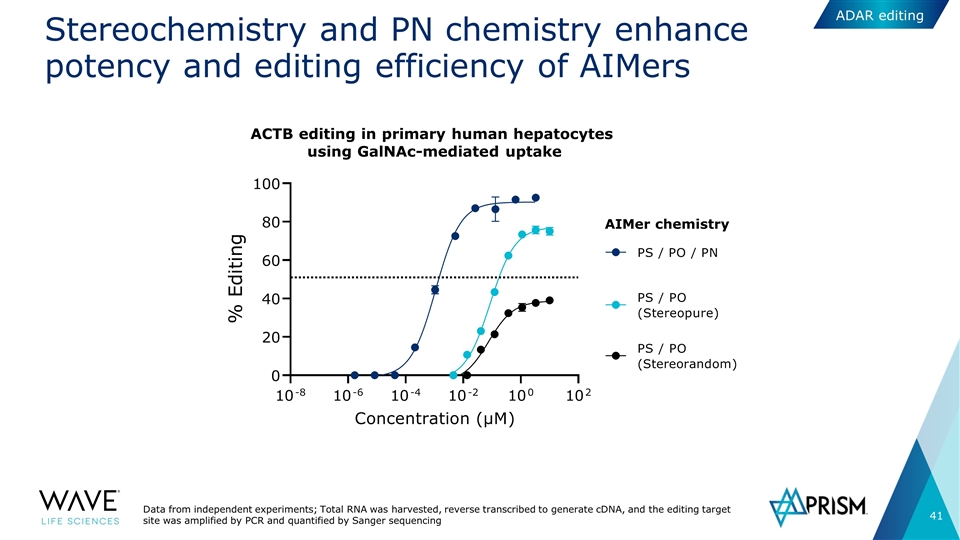
Data from independent experiments; Total RNA was harvested, reverse transcribed to generate cDNA, and the editing target site was amplified by PCR and quantified by Sanger sequencing Stereochemistry and PN chemistry enhance potency and editing efficiency of AIMers ACTB editing in primary human hepatocytes using GalNAc-mediated uptake AIMer chemistry ADAR editing
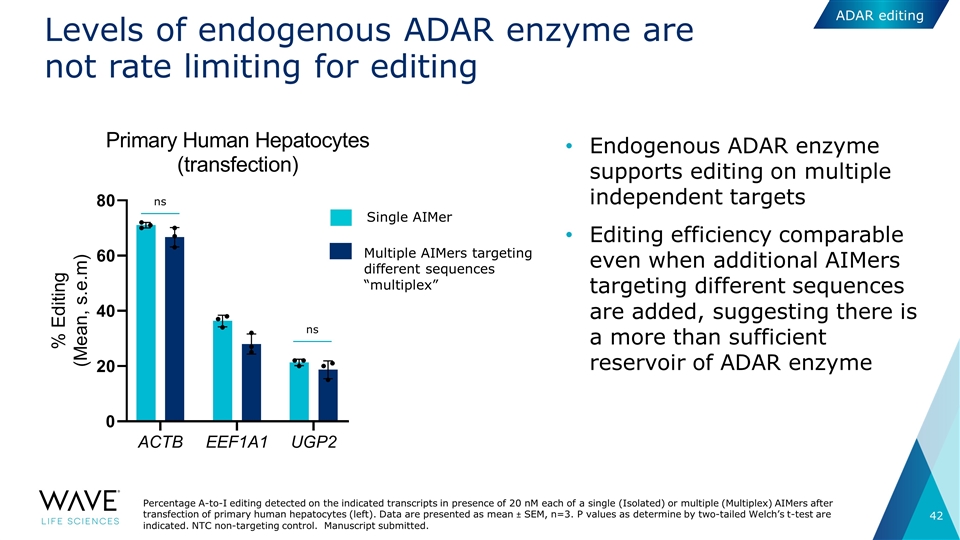
Levels of endogenous ADAR enzyme are not rate limiting for editing Percentage A-to-I editing detected on the indicated transcripts in presence of 20 nM each of a single (Isolated) or multiple (Multiplex) AIMers after transfection of primary human hepatocytes (left). Data are presented as mean ± SEM, n=3. P values as determine by two-tailed Welch’s t-test are indicated. NTC non-targeting control. Manuscript submitted. Endogenous ADAR enzyme supports editing on multiple independent targets Editing efficiency comparable even when additional AIMers targeting different sequences are added, suggesting there is a more than sufficient reservoir of ADAR enzyme Single AIMer Multiple AIMers targeting different sequences “multiplex” ns ns ADAR editing

XAX NNN AIMer mRNA target Sequence space is defined >300 unique AIMers tested containing different base pair combinations Identified base modification combinations with high editing efficiency to optimize sequence Optimization of every dimension to inform future rational design of AIMers Motif on target Motif on AIMer Learnings inform design principles deployed across future targets Example: Sequence is one of multiple dimensions for optimization Heat map for sequence impact on SAR ADAR editing
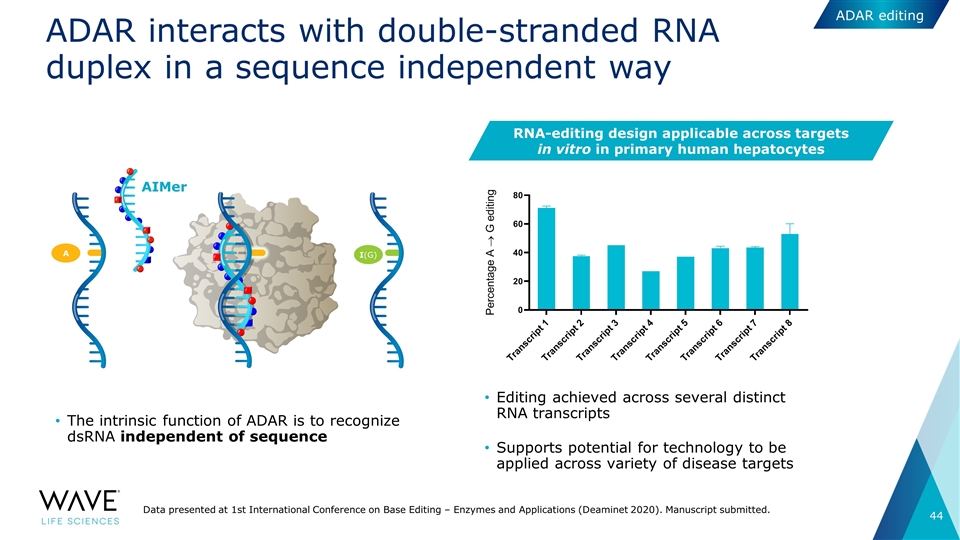
ADAR interacts with double-stranded RNA duplex in a sequence independent way RNA-editing design applicable across targets in vitro in primary human hepatocytes Editing achieved across several distinct RNA transcripts Supports potential for technology to be applied across variety of disease targets The intrinsic function of ADAR is to recognize dsRNA independent of sequence Data presented at 1st International Conference on Base Editing – Enzymes and Applications (Deaminet 2020). Manuscript submitted. I(G) A AIMer ADAR editing
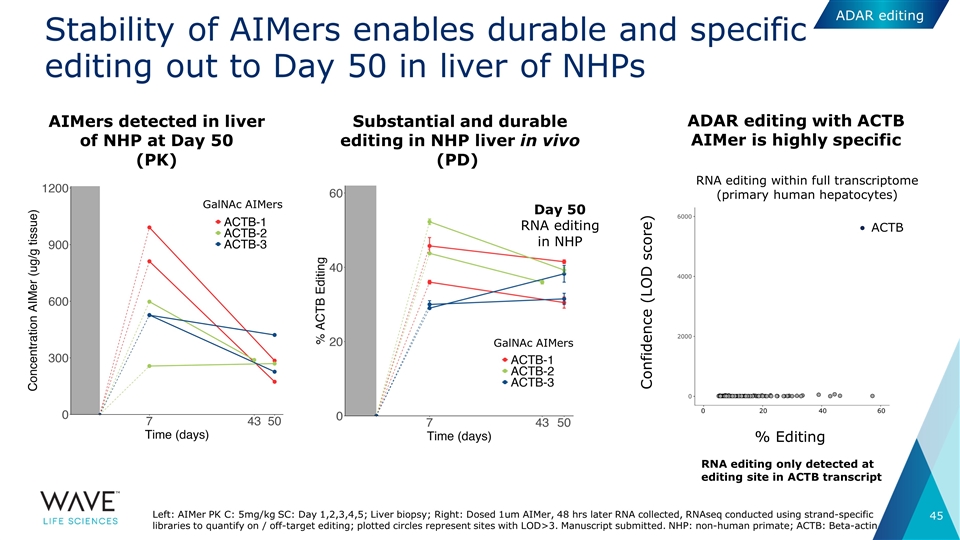
Stability of AIMers enables durable and specific editing out to Day 50 in liver of NHPs Left: AIMer PK C: 5mg/kg SC: Day 1,2,3,4,5; Liver biopsy; Right: Dosed 1um AIMer, 48 hrs later RNA collected, RNAseq conducted using strand-specific libraries to quantify on / off-target editing; plotted circles represent sites with LOD>3. Manuscript submitted. NHP: non-human primate; ACTB: Beta-actin AIMers detected in liver of NHP at Day 50 (PK) ADAR editing with ACTB AIMer is highly specific ACTB Confidence (LOD score) % Editing RNA editing within full transcriptome (primary human hepatocytes) Substantial and durable editing in NHP liver in vivo (PD) Day 50 RNA editing in NHP RNA editing only detected at editing site in ACTB transcript GalNAc AIMers GalNAc AIMers ADAR editing
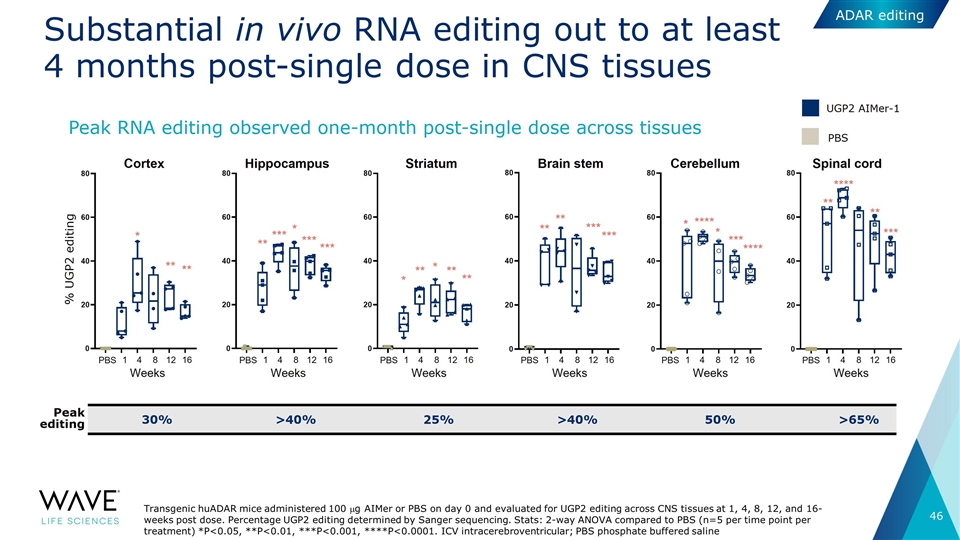
Substantial in vivo RNA editing out to at least 4 months post-single dose in CNS tissues Transgenic huADAR mice administered 100 mg AIMer or PBS on day 0 and evaluated for UGP2 editing across CNS tissues at 1, 4, 8, 12, and 16-weeks post dose. Percentage UGP2 editing determined by Sanger sequencing. Stats: 2-way ANOVA compared to PBS (n=5 per time point per treatment) *P<0.05, **P<0.01, ***P<0.001, ****P<0.0001. ICV intracerebroventricular; PBS phosphate buffered saline ADAR editing
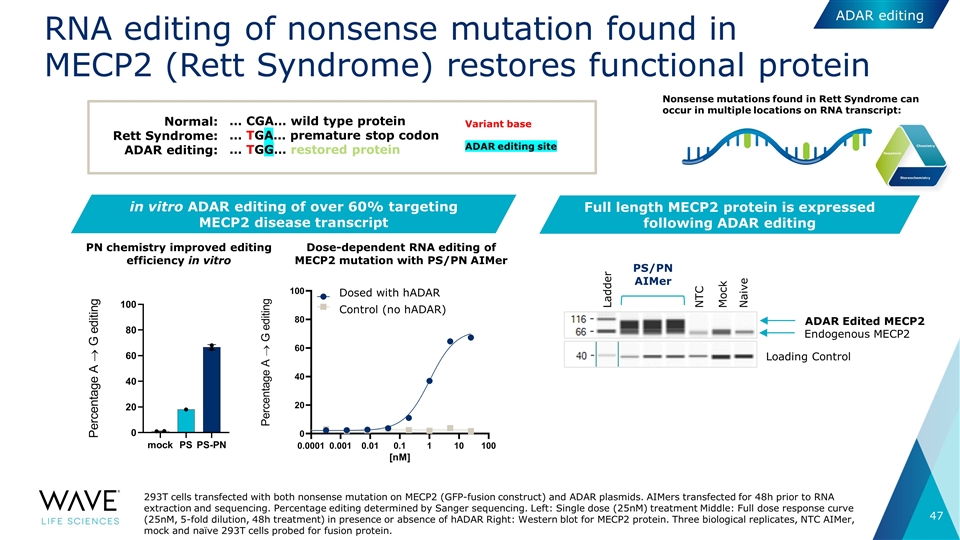
RNA editing of nonsense mutation found in MECP2 (Rett Syndrome) restores functional protein 293T cells transfected with both nonsense mutation on MECP2 (GFP-fusion construct) and ADAR plasmids. AIMers transfected for 48h prior to RNA extraction and sequencing. Percentage editing determined by Sanger sequencing. Left: Single dose (25nM) treatment Middle: Full dose response curve (25nM, 5-fold dilution, 48h treatment) in presence or absence of hADAR Right: Western blot for MECP2 protein. Three biological replicates, NTC AIMer, mock and naïve 293T cells probed for fusion protein. in vitro ADAR editing of over 60% targeting MECP2 disease transcript Full length MECP2 protein is expressed following ADAR editing Loading Control Endogenous MECP2 ADAR Edited MECP2 Mock Naive NTC Ladder Dose-dependent RNA editing of MECP2 mutation with PS/PN AIMer Control (no hADAR) PS/PN AIMer … CGA… wild type protein … TGA… premature stop codon … TGG… restored protein Normal: Rett Syndrome: ADAR editing: Variant base ADAR editing site Nonsense mutations found in Rett Syndrome can occur in multiple locations on RNA transcript: PN chemistry improved editing efficiency in vitro Dosed with hADAR ADAR editing
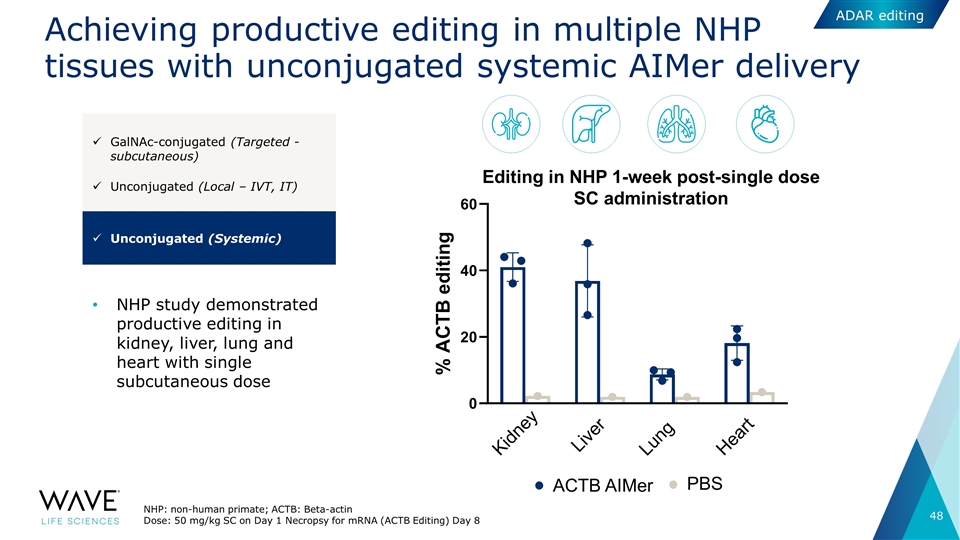
Achieving productive editing in multiple NHP tissues with unconjugated systemic AIMer delivery NHP study demonstrated productive editing in kidney, liver, lung and heart with single subcutaneous dose PBS ACTB AIMer GalNAc-conjugated (Targeted - subcutaneous) Unconjugated (Local – IVT, IT) Unconjugated (Systemic) Editing in NHP 1-week post-single dose SC administration Kidney Liver Lung Heart NHP: non-human primate; ACTB: Beta-actin Dose: 50 mg/kg SC on Day 1 Necropsy for mRNA (ACTB Editing) Day 8 ADAR editing
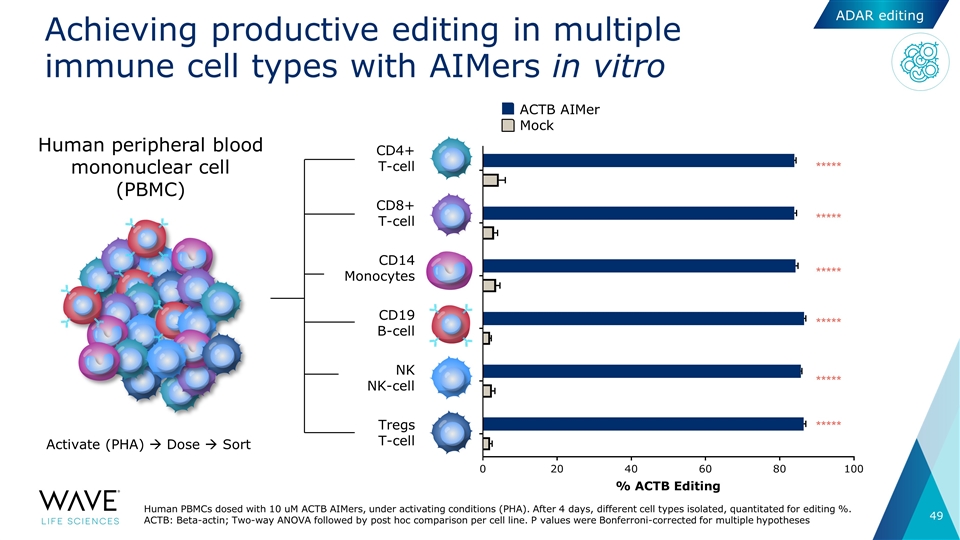
Achieving productive editing in multiple immune cell types with AIMers in vitro Human peripheral blood mononuclear cell (PBMC) CD4+ T-cell CD19 B-cell CD14 Monocytes Tregs T-cell CD8+ T-cell NK NK-cell Human PBMCs dosed with 10 uM ACTB AIMers, under activating conditions (PHA). After 4 days, different cell types isolated, quantitated for editing %. ACTB: Beta-actin; Two-way ANOVA followed by post hoc comparison per cell line. P values were Bonferroni-corrected for multiple hypotheses ACTB AIMer Mock Activate (PHA) à Dose à Sort ***** ***** ***** ***** ***** ***** ADAR editing
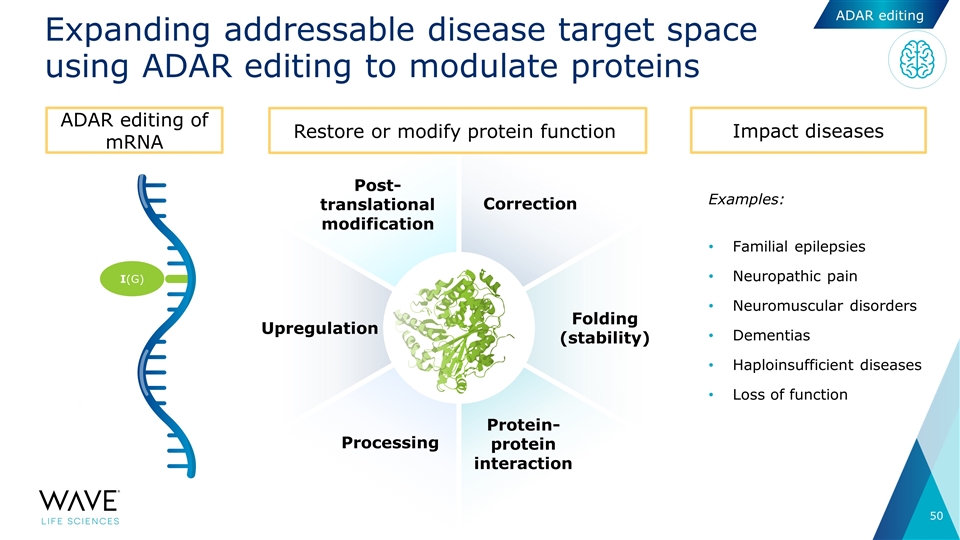
Expanding addressable disease target space using ADAR editing to modulate proteins Correction Protein- protein interaction Upregulation Processing Folding (stability) Post-translational modification ADAR editing of mRNA Restore or modify protein function Impact diseases Examples: Familial epilepsies Neuropathic pain Neuromuscular disorders Dementias Haploinsufficient diseases Loss of function I(G) ADAR editing
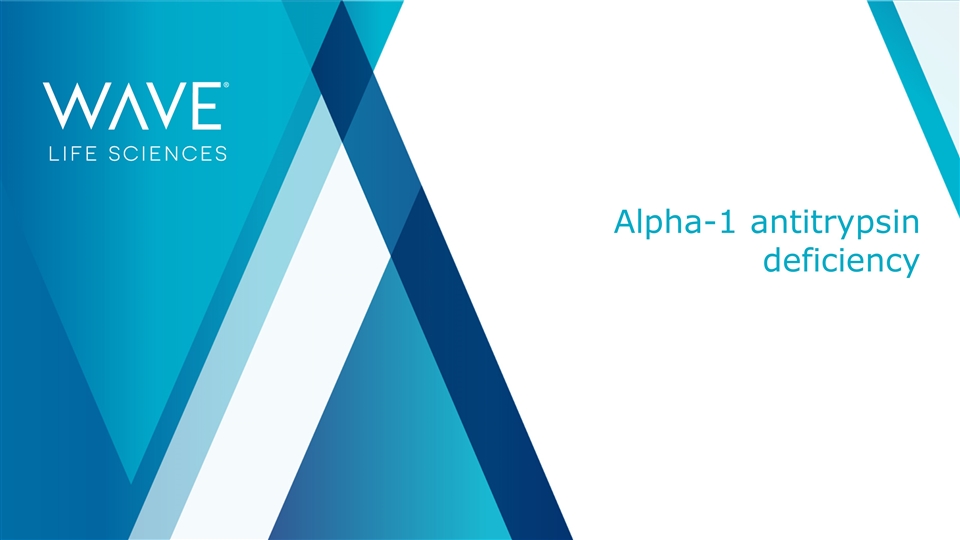
Alpha-1 antitrypsin deficiency
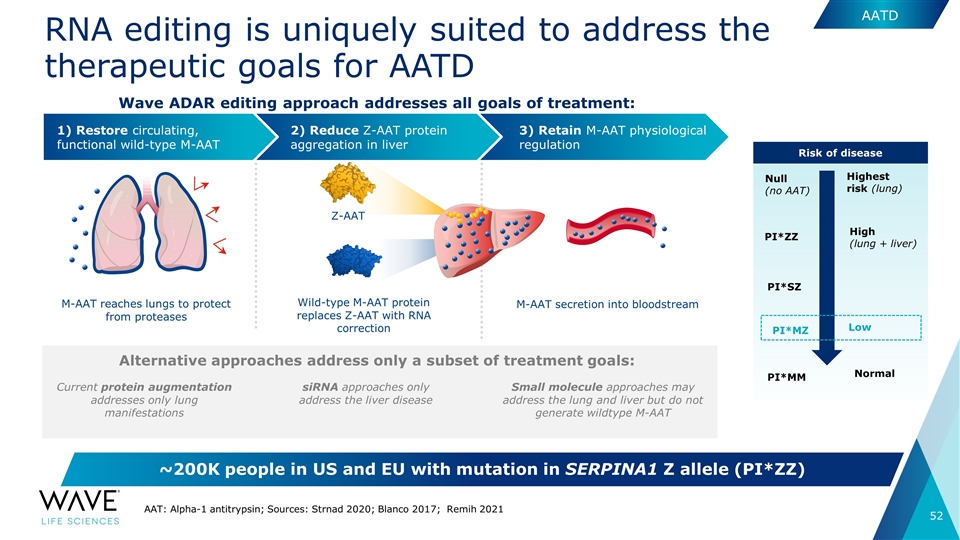
3) Retain M-AAT physiological regulation 2) Reduce Z-AAT protein aggregation in liver RNA editing is uniquely suited to address the therapeutic goals for AATD M-AAT reaches lungs to protect from proteases M-AAT secretion into bloodstream AAT: Alpha-1 antitrypsin; Sources: Strnad 2020; Blanco 2017; Remih 2021 Wave ADAR editing approach addresses all goals of treatment: PI*MM Normal PI*MZ Low PI*SZ PI*ZZ High (lung + liver) Null (no AAT) Highest risk (lung) Risk of disease Wild-type M-AAT protein replaces Z-AAT with RNA correction Z-AAT 1) Restore circulating, functional wild-type M-AAT ~200K people in US and EU with mutation in SERPINA1 Z allele (PI*ZZ) Current protein augmentation addresses only lung manifestations siRNA approaches only address the liver disease Alternative approaches address only a subset of treatment goals: Small molecule approaches may address the lung and liver but do not generate wildtype M-AAT AATD
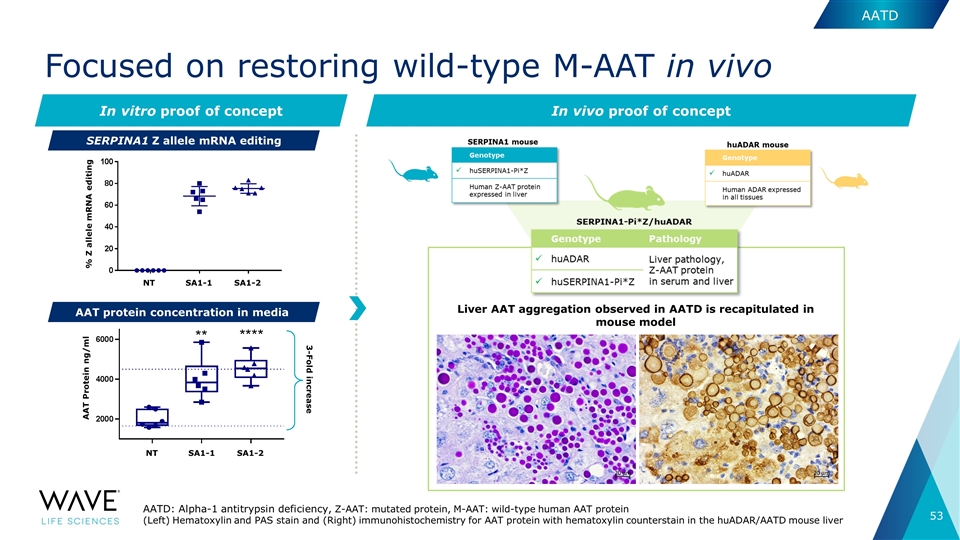
AAT Protein ng/ml SA1-1 NT SA1-2 % Z allele mRNA editing SA1-1 NT SA1-2 Focused on restoring wild-type M-AAT in vivo In vivo proof of concept In vitro proof of concept SERPINA1 Z allele mRNA editing AAT protein concentration in media 3-Fold increase Liver AAT aggregation observed in AATD is recapitulated in mouse model AATD: Alpha-1 antitrypsin deficiency, Z-AAT: mutated protein, M-AAT: wild-type human AAT protein (Left) Hematoxylin and PAS stain and (Right) immunohistochemistry for AAT protein with hematoxylin counterstain in the huADAR/AATD mouse liver AATD
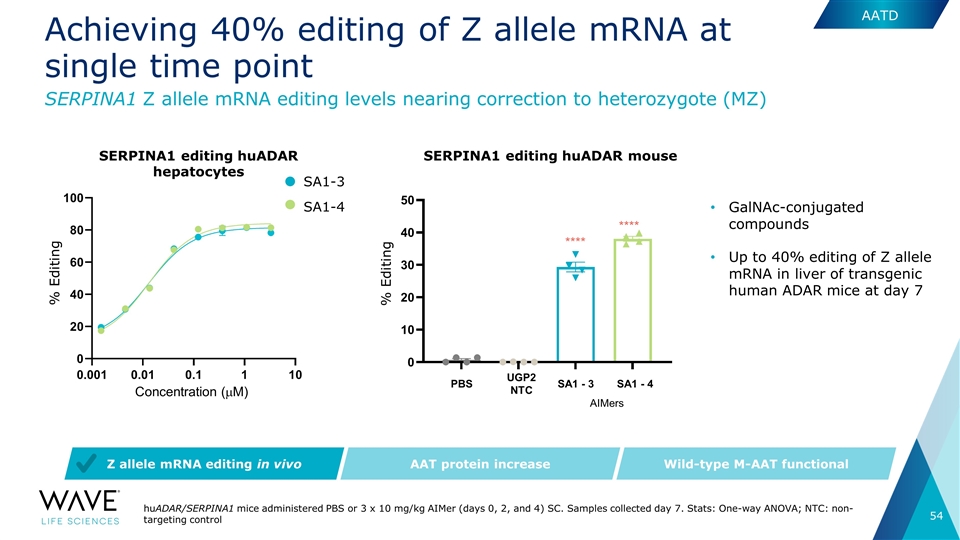
Achieving 40% editing of Z allele mRNA at single time point SERPINA1 Z allele mRNA editing levels nearing correction to heterozygote (MZ) AAT protein increase Wild-type M-AAT functional Z allele mRNA editing in vivo GalNAc-conjugated compounds Up to 40% editing of Z allele mRNA in liver of transgenic human ADAR mice at day 7 huADAR/SERPINA1 mice administered PBS or 3 x 10 mg/kg AIMer (days 0, 2, and 4) SC. Samples collected day 7. Stats: One-way ANOVA; NTC: non-targeting control SERPINA1 editing huADAR mouse SA1 - 3 SA1 - 4 UGP2 NTC PBS AIMers % Editing **** **** SERPINA1 editing huADAR hepatocytes % Editing SA1-3 SA1-4 Concentration (mM) AATD
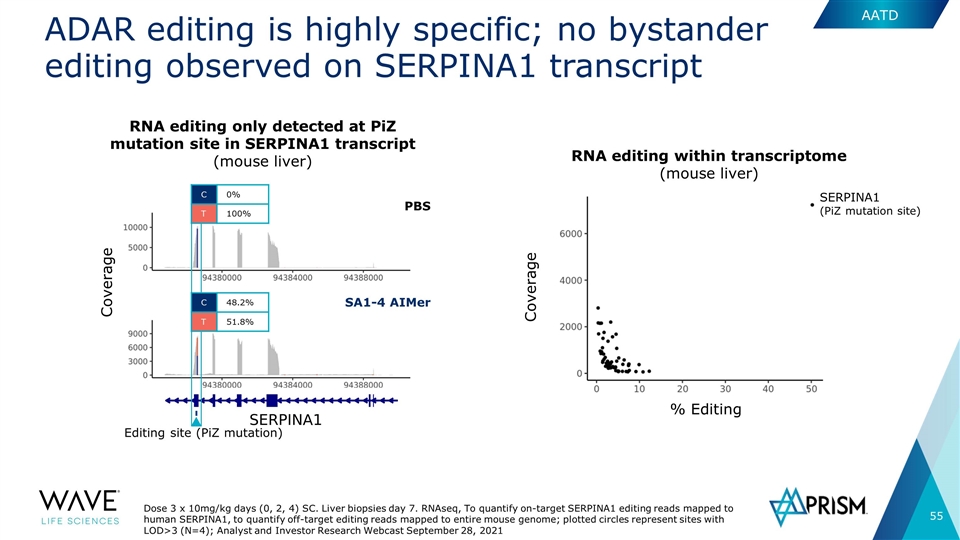
RNA editing only detected at PiZ mutation site in SERPINA1 transcript (mouse liver) RNA editing within transcriptome (mouse liver) ADAR editing is highly specific; no bystander editing observed on SERPINA1 transcript SERPINA1 (PiZ mutation site) % Editing Dose 3 x 10mg/kg days (0, 2, 4) SC. Liver biopsies day 7. RNAseq, To quantify on-target SERPINA1 editing reads mapped to human SERPINA1, to quantify off-target editing reads mapped to entire mouse genome; plotted circles represent sites with LOD>3 (N=4); Analyst and Investor Research Webcast September 28, 2021 Coverage Coverage Editing site (PiZ mutation) PBS SA1-4 AIMer C 0% T 100% C 48.2% T 51.8% AATD
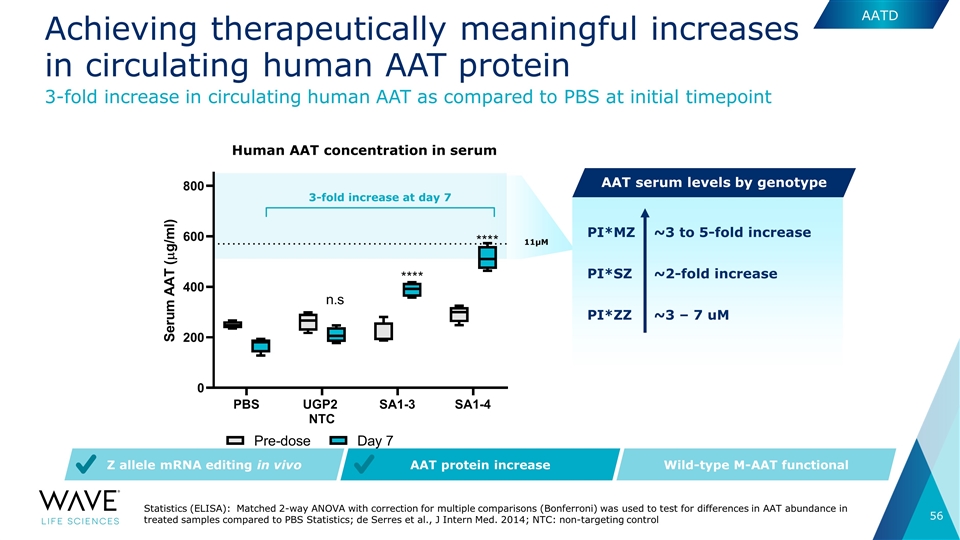
Statistics (ELISA): Matched 2-way ANOVA with correction for multiple comparisons (Bonferroni) was used to test for differences in AAT abundance in treated samples compared to PBS Statistics; de Serres et al., J Intern Med. 2014; NTC: non-targeting control Achieving therapeutically meaningful increases in circulating human AAT protein AAT protein increase Wild-type M-AAT functional Z allele mRNA editing in vivo Human AAT concentration in serum 3-fold increase in circulating human AAT as compared to PBS at initial timepoint PI*SZ ~2-fold increase ~3 to 5-fold increase PI*MZ PI*ZZ ~3 – 7 uM AAT serum levels by genotype 3-fold increase at day 7 11µM AATD
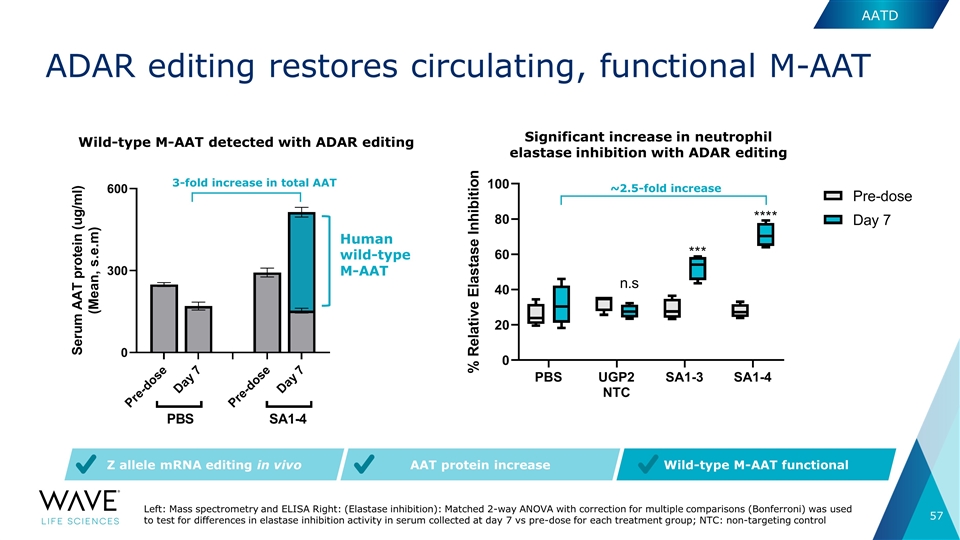
ADAR editing restores circulating, functional M-AAT Human wild-type M-AAT AAT protein increase Wild-type M-AAT functional Z allele mRNA editing in vivo Wild-type M-AAT detected with ADAR editing ~2.5-fold increase Significant increase in neutrophil elastase inhibition with ADAR editing 3-fold increase in total AAT Left: Mass spectrometry and ELISA Right: (Elastase inhibition): Matched 2-way ANOVA with correction for multiple comparisons (Bonferroni) was used to test for differences in elastase inhibition activity in serum collected at day 7 vs pre-dose for each treatment group; NTC: non-targeting control AATD
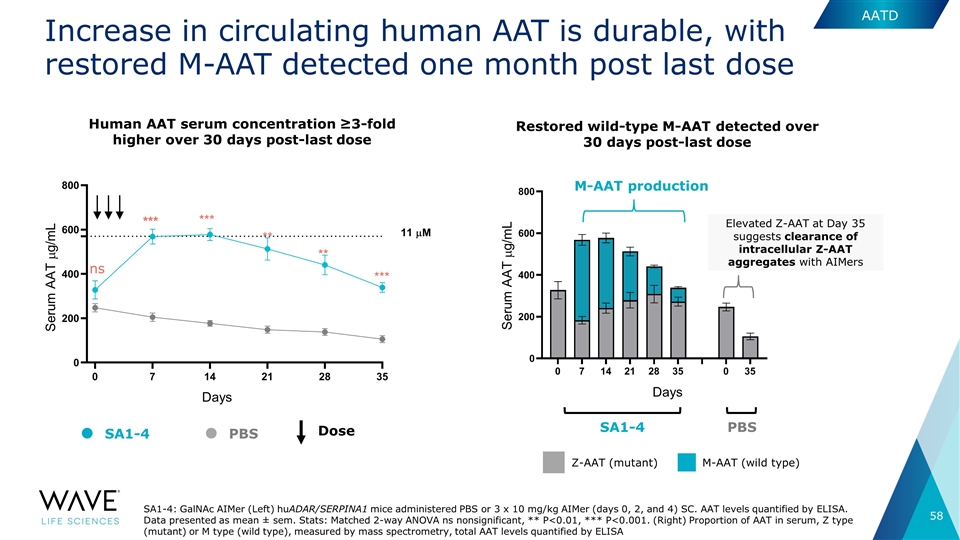
Serum AAT mg/mL PBS PBS SA1-4 SA1-4 Dose Days ns *** *** ** *** 11 mM ** Increase in circulating human AAT is durable, with restored M-AAT detected one month post last dose SA1-4: GalNAc AIMer (Left) huADAR/SERPINA1 mice administered PBS or 3 x 10 mg/kg AIMer (days 0, 2, and 4) SC. AAT levels quantified by ELISA. Data presented as mean ± sem. Stats: Matched 2-way ANOVA ns nonsignificant, ** P<0.01, *** P<0.001. (Right) Proportion of AAT in serum, Z type (mutant) or M type (wild type), measured by mass spectrometry, total AAT levels quantified by ELISA Serum AAT mg/mL Days M-AAT production Elevated Z-AAT at Day 35 suggests clearance of intracellular Z-AAT aggregates with AIMers Human AAT serum concentration ≥3-fold higher over 30 days post-last dose Restored wild-type M-AAT detected over 30 days post-last dose Z-AAT (mutant) M-AAT (wild type) AATD
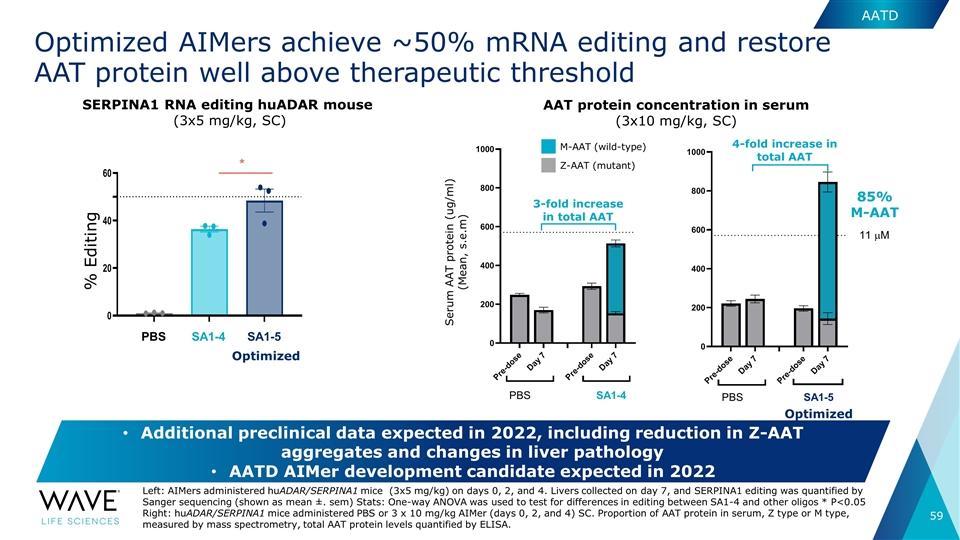
Optimized AIMers achieve ~50% mRNA editing and restore AAT protein well above therapeutic threshold Left: AIMers administered huADAR/SERPINA1 mice (3x5 mg/kg) on days 0, 2, and 4. Livers collected on day 7, and SERPINA1 editing was quantified by Sanger sequencing (shown as mean ±. sem) Stats: One-way ANOVA was used to test for differences in editing between SA1-4 and other oligos * P<0.05 Right: huADAR/SERPINA1 mice administered PBS or 3 x 10 mg/kg AIMer (days 0, 2, and 4) SC. Proportion of AAT protein in serum, Z type or M type, measured by mass spectrometry, total AAT protein levels quantified by ELISA. SERPINA1 RNA editing huADAR mouse (3x5 mg/kg, SC) % Editing PBS SA1-4 SA1-5 Optimized * 85% M-AAT 11 mM Z-AAT (mutant) M-AAT (wild-type) 4-fold increase in total AAT 3-fold increase in total AAT SA1-4 PBS SA1-5 PBS AAT protein concentration in serum (3x10 mg/kg, SC) Serum AAT protein (ug/ml) (Mean, s.e.m) Optimized Additional preclinical data expected in 2022, including reduction in Z-AAT aggregates and changes in liver pathology AATD AIMer development candidate expected in 2022 AATD
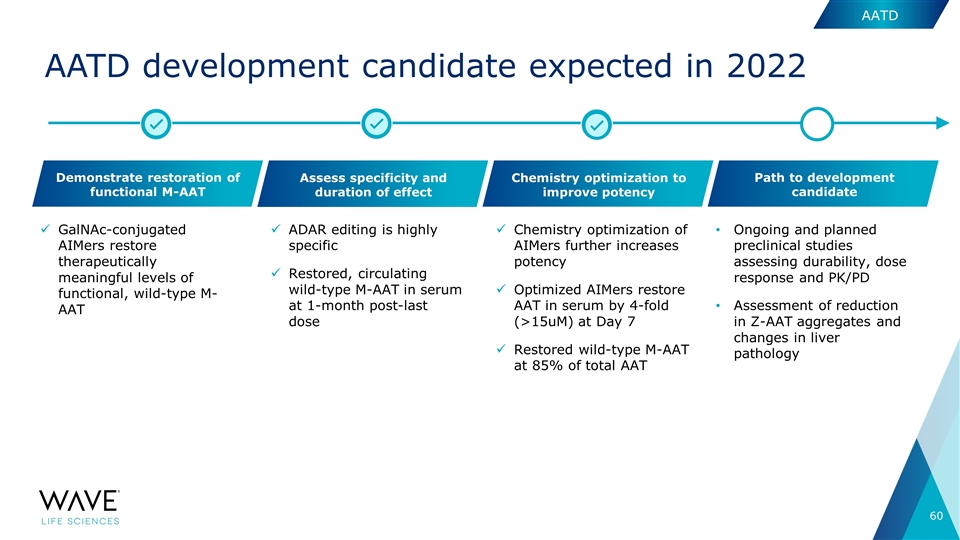
Demonstrate restoration of functional M-AAT Chemistry optimization to improve potency Path to development candidate ADAR editing is highly specific Restored, circulating wild-type M-AAT in serum at 1-month post-last dose Chemistry optimization of AIMers further increases potency Optimized AIMers restore AAT in serum by 4-fold (>15uM) at Day 7 Restored wild-type M-AAT at 85% of total AAT Assess specificity and duration of effect AATD development candidate expected in 2022 GalNAc-conjugated AIMers restore therapeutically meaningful levels of functional, wild-type M-AAT Ongoing and planned preclinical studies assessing durability, dose response and PK/PD Assessment of reduction in Z-AAT aggregates and changes in liver pathology AATD
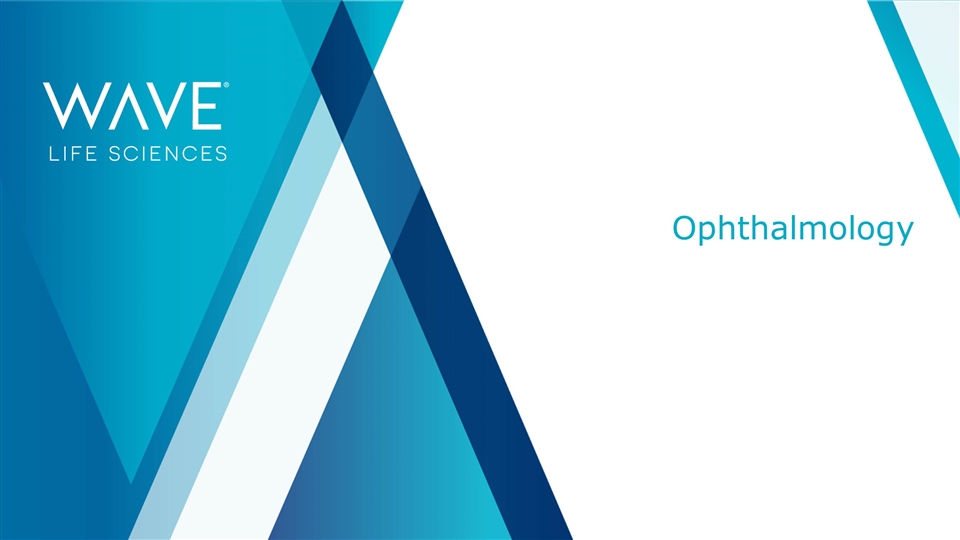
Ophthalmology
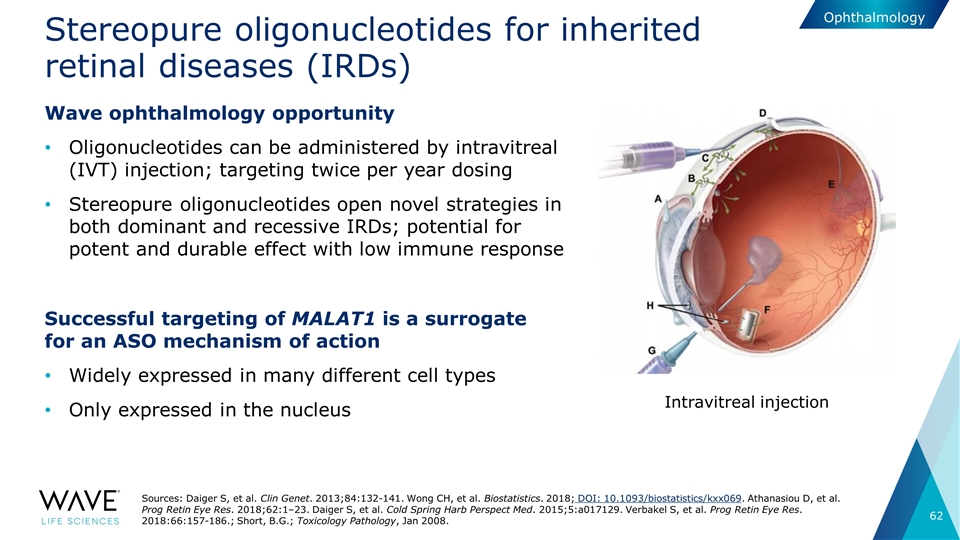
Stereopure oligonucleotides for inherited retinal diseases (IRDs) Wave ophthalmology opportunity Oligonucleotides can be administered by intravitreal (IVT) injection; targeting twice per year dosing Stereopure oligonucleotides open novel strategies in both dominant and recessive IRDs; potential for potent and durable effect with low immune response Successful targeting of MALAT1 is a surrogate for an ASO mechanism of action Widely expressed in many different cell types Only expressed in the nucleus Intravitreal injection Sources: Daiger S, et al. Clin Genet. 2013;84:132-141. Wong CH, et al. Biostatistics. 2018; DOI: 10.1093/biostatistics/kxx069. Athanasiou D, et al. Prog Retin Eye Res. 2018;62:1–23. Daiger S, et al. Cold Spring Harb Perspect Med. 2015;5:a017129. Verbakel S, et al. Prog Retin Eye Res. 2018:66:157-186.; Short, B.G.; Toxicology Pathology, Jan 2008. Ophthalmology
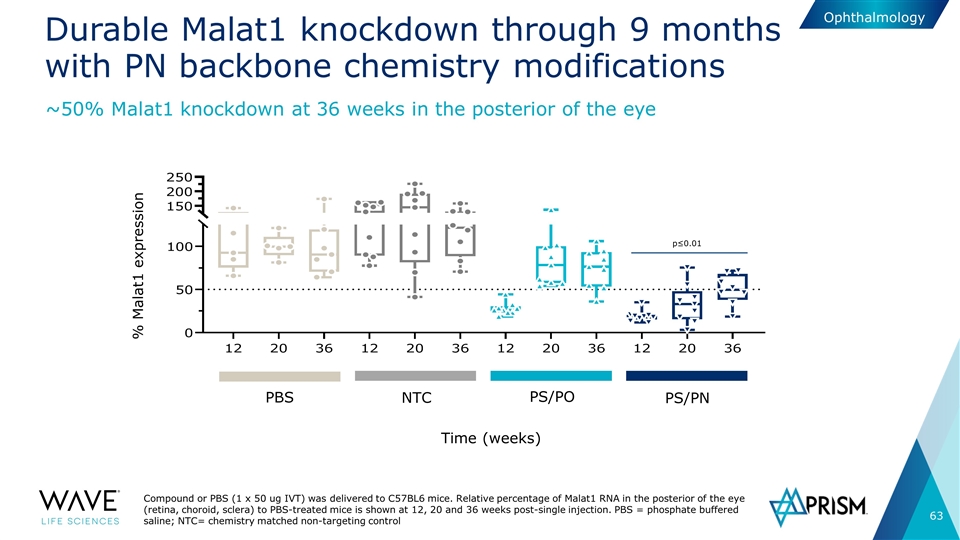
Durable Malat1 knockdown through 9 months with PN backbone chemistry modifications Compound or PBS (1 x 50 ug IVT) was delivered to C57BL6 mice. Relative percentage of Malat1 RNA in the posterior of the eye (retina, choroid, sclera) to PBS-treated mice is shown at 12, 20 and 36 weeks post-single injection. PBS = phosphate buffered saline; NTC= chemistry matched non-targeting control ~50% Malat1 knockdown at 36 weeks in the posterior of the eye PBS NTC PS/PO PS/PN % Malat1 expression Time (weeks) p≤0.01 Ophthalmology
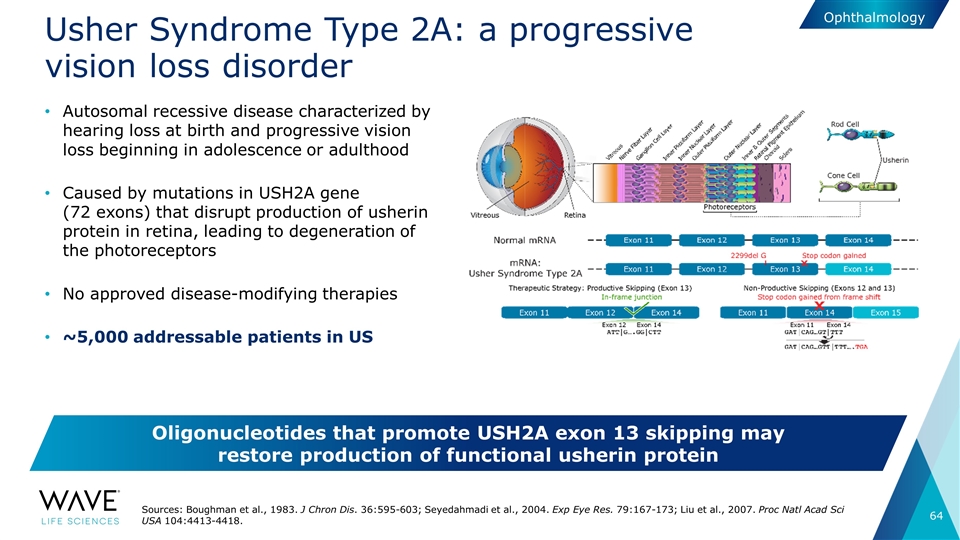
Usher Syndrome Type 2A: a progressive vision loss disorder Autosomal recessive disease characterized by hearing loss at birth and progressive vision loss beginning in adolescence or adulthood Caused by mutations in USH2A gene (72 exons) that disrupt production of usherin protein in retina, leading to degeneration of the photoreceptors No approved disease-modifying therapies ~5,000 addressable patients in US Sources: Boughman et al., 1983. J Chron Dis. 36:595-603; Seyedahmadi et al., 2004. Exp Eye Res. 79:167-173; Liu et al., 2007. Proc Natl Acad Sci USA 104:4413-4418. Oligonucleotides that promote USH2A exon 13 skipping may restore production of functional usherin protein Ophthalmology
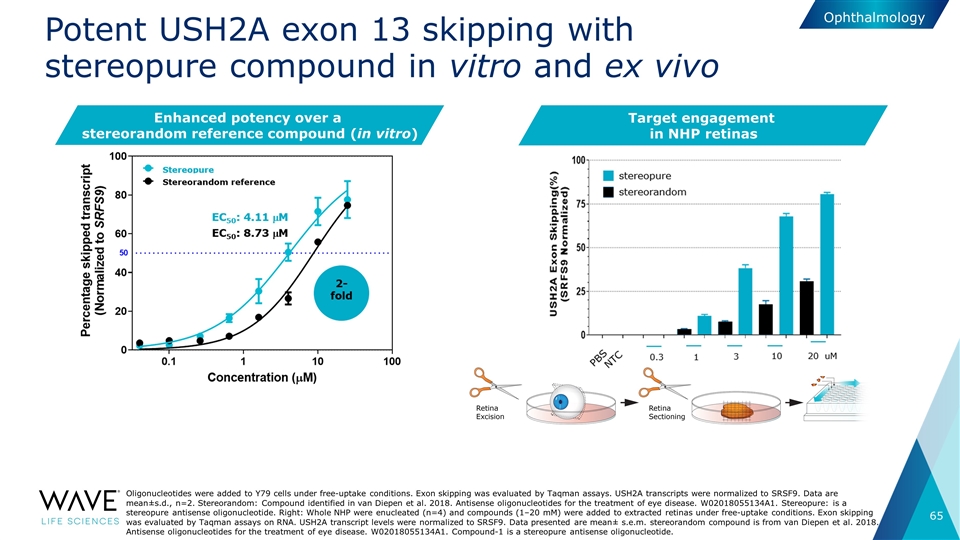
Potent USH2A exon 13 skipping with stereopure compound in vitro and ex vivo Oligonucleotides were added to Y79 cells under free-uptake conditions. Exon skipping was evaluated by Taqman assays. USH2A transcripts were normalized to SRSF9. Data are mean±s.d., n=2. Stereorandom: Compound identified in van Diepen et al. 2018. Antisense oligonucleotides for the treatment of eye disease. W02018055134A1. Stereopure: is a stereopure antisense oligonucleotide. Right: Whole NHP were enucleated (n=4) and compounds (1–20 mM) were added to extracted retinas under free-uptake conditions. Exon skipping was evaluated by Taqman assays on RNA. USH2A transcript levels were normalized to SRSF9. Data presented are mean± s.e.m. stereorandom compound is from van Diepen et al. 2018. Antisense oligonucleotides for the treatment of eye disease. W02018055134A1. Compound-1 is a stereopure antisense oligonucleotide. Enhanced potency over a stereorandom reference compound (in vitro) Ophthalmology Target engagement in NHP retinas
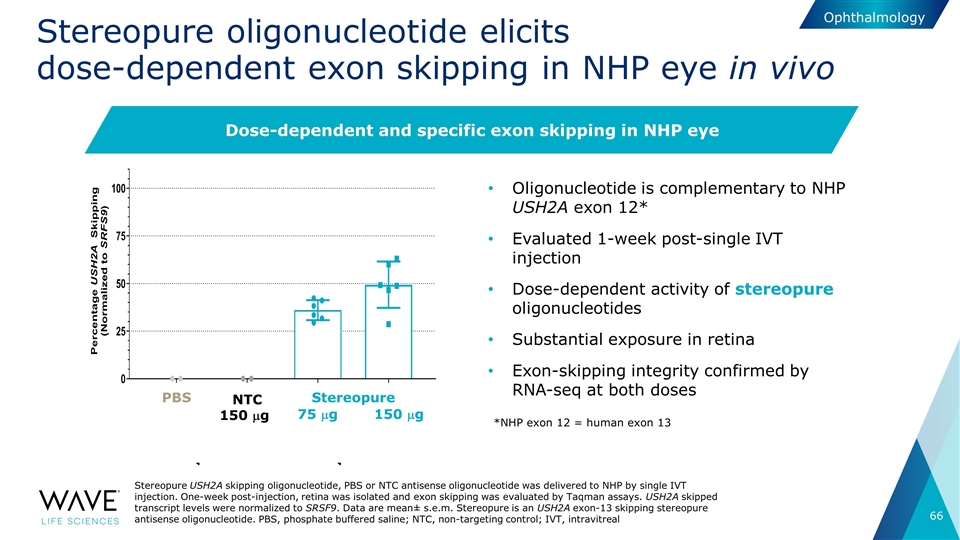
Stereopure oligonucleotide elicits dose-dependent exon skipping in NHP eye in vivo Oligonucleotide is complementary to NHP USH2A exon 12* Evaluated 1-week post-single IVT injection Dose-dependent activity of stereopure oligonucleotides Substantial exposure in retina Exon-skipping integrity confirmed by RNA-seq at both doses NTC 150 mg 75 mg 150 mg PBS Stereopure Stereopure USH2A skipping oligonucleotide, PBS or NTC antisense oligonucleotide was delivered to NHP by single IVT injection. One-week post-injection, retina was isolated and exon skipping was evaluated by Taqman assays. USH2A skipped transcript levels were normalized to SRSF9. Data are mean± s.e.m. Stereopure is an USH2A exon-13 skipping stereopure antisense oligonucleotide. PBS, phosphate buffered saline; NTC, non-targeting control; IVT, intravitreal Dose-dependent and specific exon skipping in NHP eye *NHP exon 12 = human exon 13 Ophthalmology
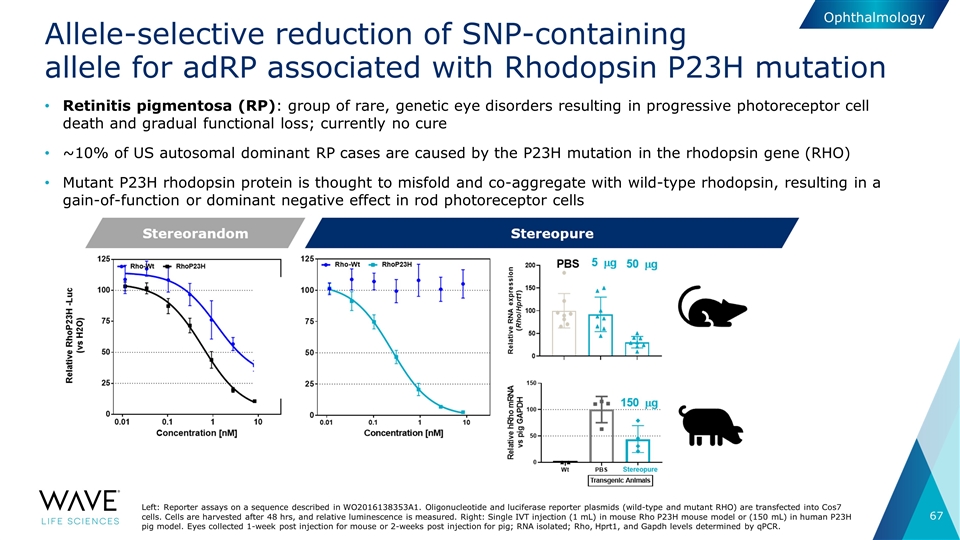
Allele-selective reduction of SNP-containing allele for adRP associated with Rhodopsin P23H mutation Left: Reporter assays on a sequence described in WO2016138353A1. Oligonucleotide and luciferase reporter plasmids (wild-type and mutant RHO) are transfected into Cos7 cells. Cells are harvested after 48 hrs, and relative luminescence is measured. Right: Single IVT injection (1 mL) in mouse Rho P23H mouse model or (150 mL) in human P23H pig model. Eyes collected 1-week post injection for mouse or 2-weeks post injection for pig; RNA isolated; Rho, Hprt1, and Gapdh levels determined by qPCR. Ophthalmology Retinitis pigmentosa (RP): group of rare, genetic eye disorders resulting in progressive photoreceptor cell death and gradual functional loss; currently no cure ~10% of US autosomal dominant RP cases are caused by the P23H mutation in the rhodopsin gene (RHO) Mutant P23H rhodopsin protein is thought to misfold and co-aggregate with wild-type rhodopsin, resulting in a gain-of-function or dominant negative effect in rod photoreceptor cells
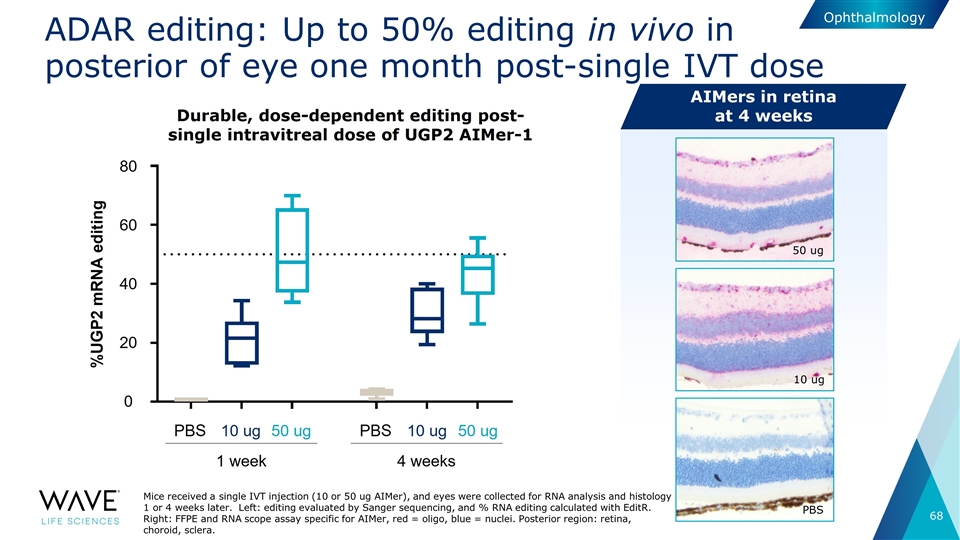
AIMers in retina at 4 weeks ADAR editing: Up to 50% editing in vivo in posterior of eye one month post-single IVT dose Mice received a single IVT injection (10 or 50 ug AIMer), and eyes were collected for RNA analysis and histology 1 or 4 weeks later. Left: editing evaluated by Sanger sequencing, and % RNA editing calculated with EditR. Right: FFPE and RNA scope assay specific for AIMer, red = oligo, blue = nuclei. Posterior region: retina, choroid, sclera. PBS 10 ug 50 ug Ophthalmology
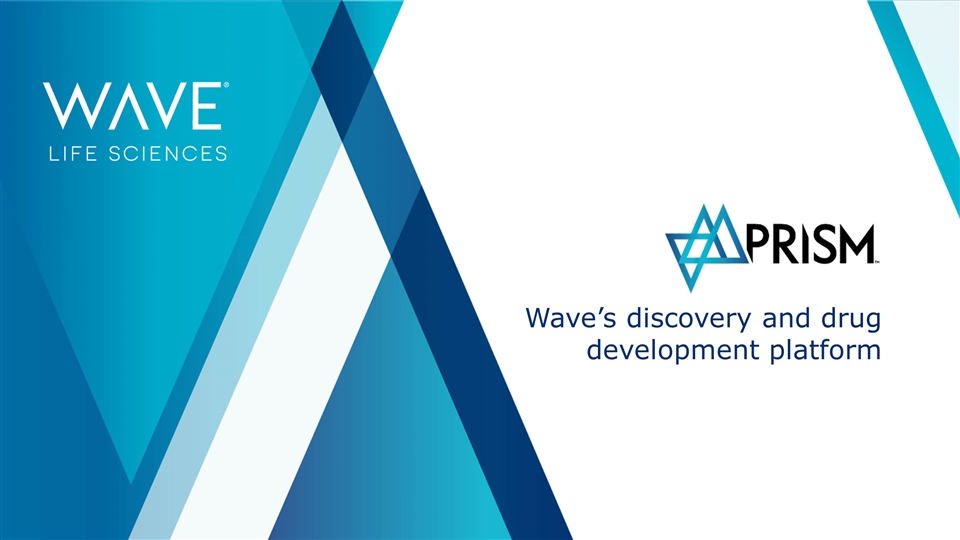
Wave’s discovery and drug development platform
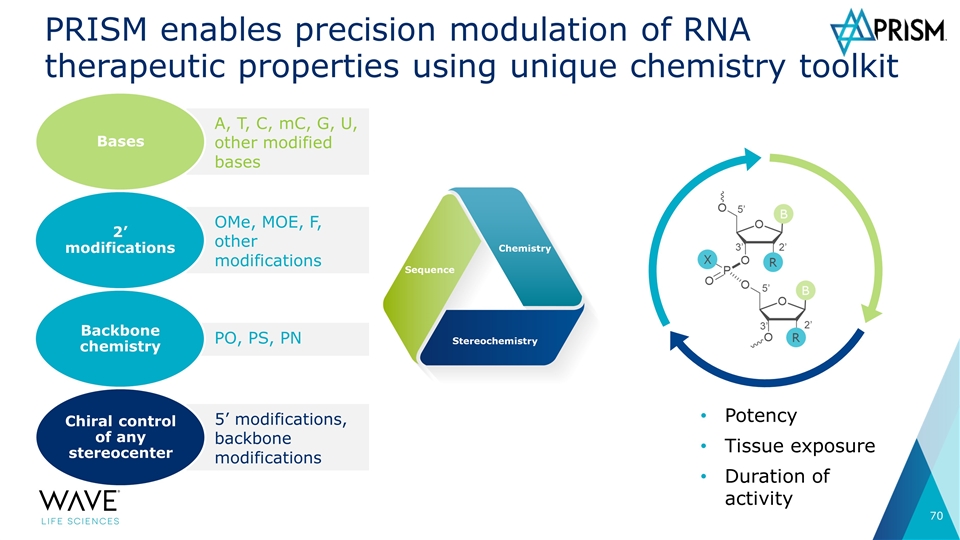
OMe, MOE, F, other modifications PO, PS, PN 5’ modifications, backbone modifications A, T, C, mC, G, U, other modified bases PRISM enables precision modulation of RNA therapeutic properties using unique chemistry toolkit 2’ modifications Backbone chemistry Bases Chiral control of any stereocenter Potency Tissue exposure Duration of activity
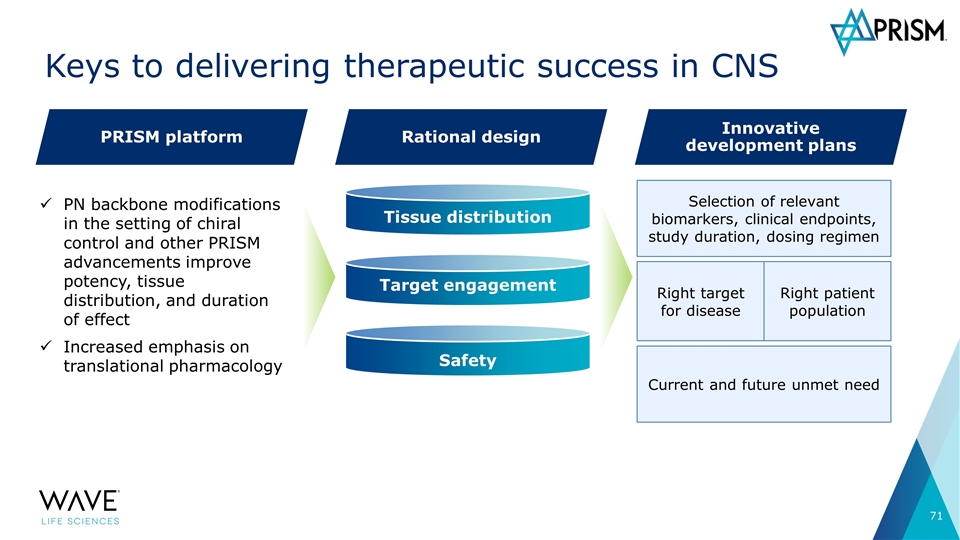
Keys to delivering therapeutic success in CNS Current and future unmet need Right target for disease Right patient population Selection of relevant biomarkers, clinical endpoints, study duration, dosing regimen PRISM platform PN backbone modifications in the setting of chiral control and other PRISM advancements improve potency, tissue distribution, and duration of effect Increased emphasis on translational pharmacology PRISM platform Rational design Innovative development plans Safety Target engagement Tissue distribution
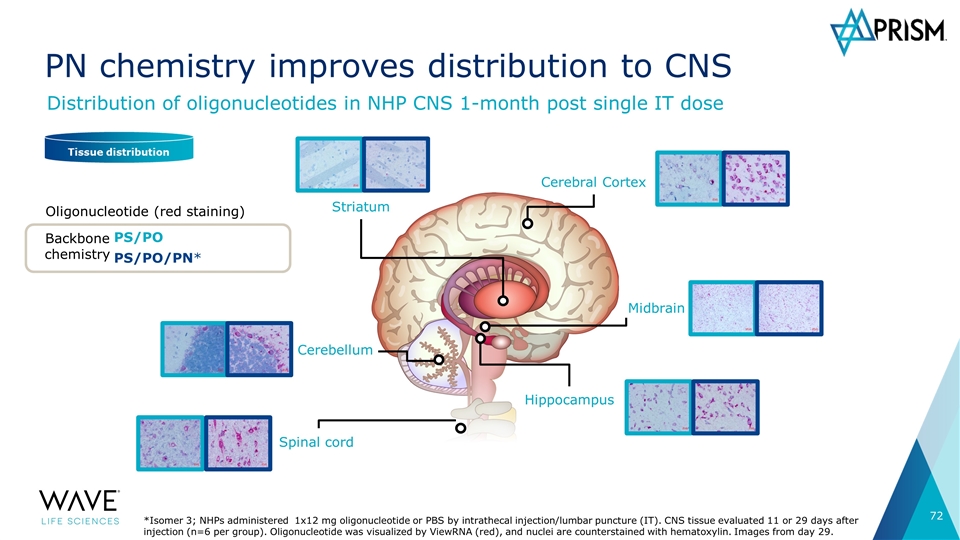
PN chemistry improves distribution to CNS *Isomer 3; NHPs administered 1x12 mg oligonucleotide or PBS by intrathecal injection/lumbar puncture (IT). CNS tissue evaluated 11 or 29 days after injection (n=6 per group). Oligonucleotide was visualized by ViewRNA (red), and nuclei are counterstained with hematoxylin. Images from day 29. Cerebral Cortex Cerebellum Striatum Hippocampus Spinal cord PS/PO PS/PO/PN* Backbone chemistry Midbrain Distribution of oligonucleotides in NHP CNS 1-month post single IT dose Oligonucleotide (red staining)
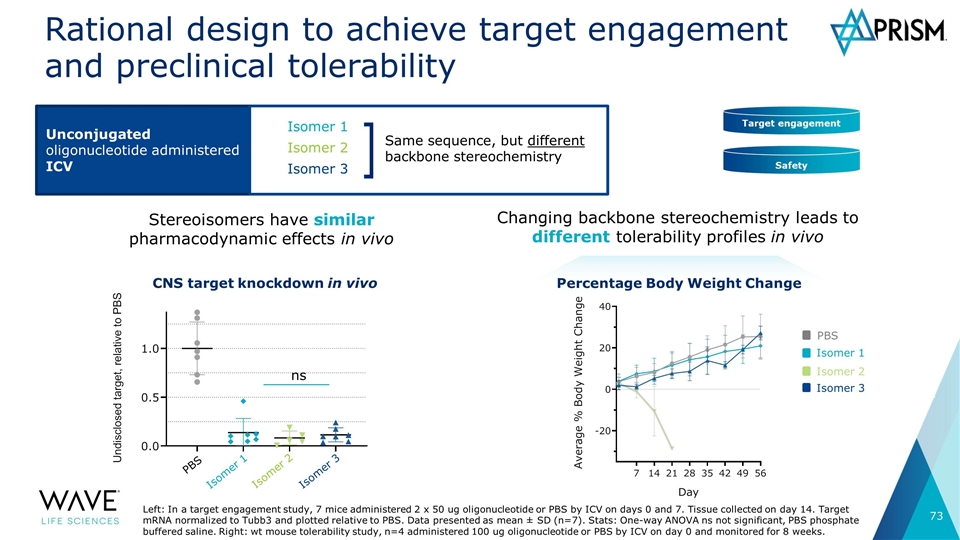
Rational design to achieve target engagement and preclinical tolerability Isomer 1 Isomer 2 ns Stereoisomers have similar pharmacodynamic effects in vivo Changing backbone stereochemistry leads to different tolerability profiles in vivo Same sequence, but different backbone stereochemistry Unconjugated oligonucleotide administered ICV Isomer 2 Left: In a target engagement study, 7 mice administered 2 x 50 ug oligonucleotide or PBS by ICV on days 0 and 7. Tissue collected on day 14. Target mRNA normalized to Tubb3 and plotted relative to PBS. Data presented as mean ± SD (n=7). Stats: One-way ANOVA ns not significant, PBS phosphate buffered saline. Right: wt mouse tolerability study, n=4 administered 100 ug oligonucleotide or PBS by ICV on day 0 and monitored for 8 weeks. Percentage Body Weight Change CNS target knockdown in vivo Isomer 1 PBS PBS Isomer 1 Isomer 2 Isomer 3 Isomer 3 Isomer 3
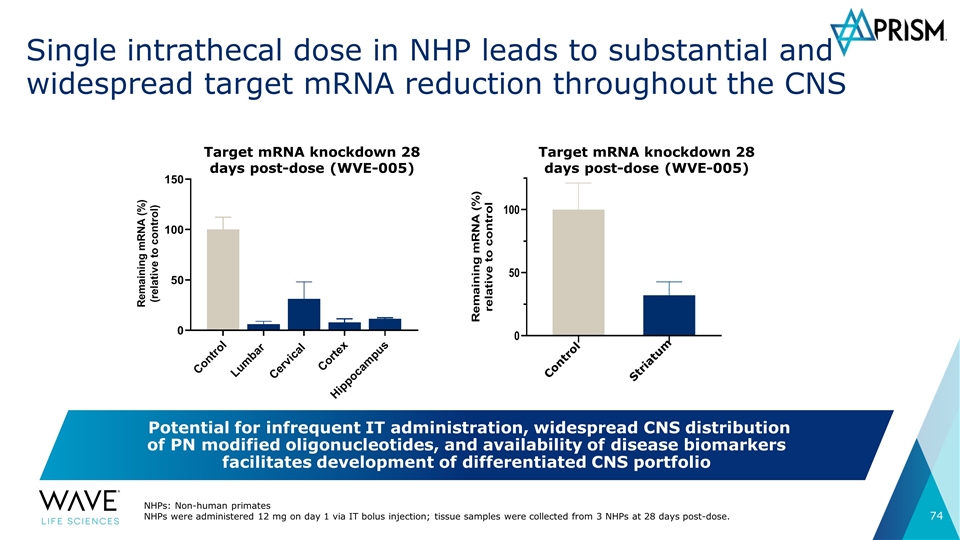
Single intrathecal dose in NHP leads to substantial and widespread target mRNA reduction throughout the CNS Target mRNA knockdown 28 days post-dose (WVE-005) Striatum Control NHPs: Non-human primates NHPs were administered 12 mg on day 1 via IT bolus injection; tissue samples were collected from 3 NHPs at 28 days post-dose. Target mRNA knockdown 28 days post-dose (WVE-005) Potential for infrequent IT administration, widespread CNS distribution of PN modified oligonucleotides, and availability of disease biomarkers facilitates development of differentiated CNS portfolio
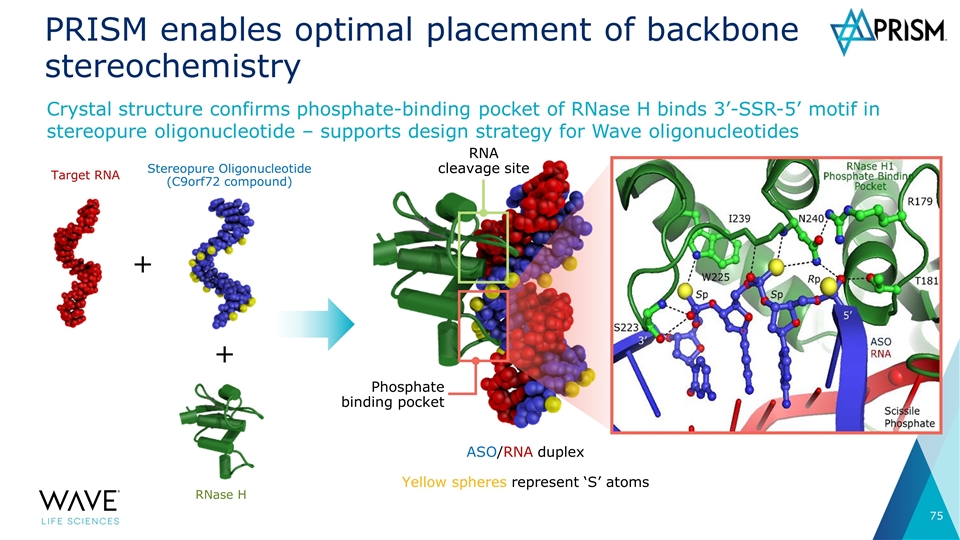
PRISM enables optimal placement of backbone stereochemistry Crystal structure confirms phosphate-binding pocket of RNase H binds 3’-SSR-5’ motif in stereopure oligonucleotide – supports design strategy for Wave oligonucleotides ASO/RNA duplex Yellow spheres represent ‘S’ atoms Phosphate binding pocket RNA cleavage site Target RNA Stereopure Oligonucleotide (C9orf72 compound) RNase H + +
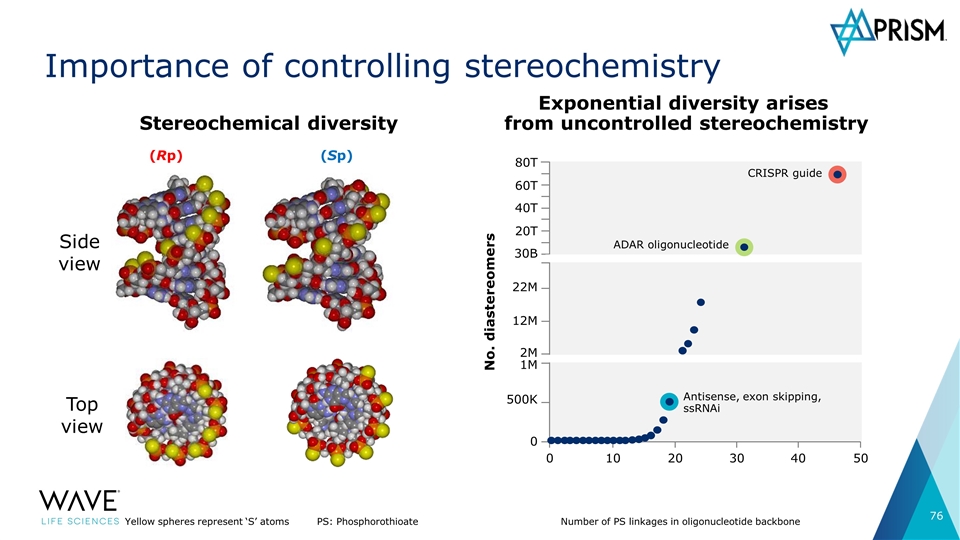
Importance of controlling stereochemistry (Rp) (Sp) Top view Side view Yellow spheres represent ‘S’ atomsPS: Phosphorothioate Number of PS linkages in oligonucleotide backbone No. diastereomers 80T 60T 40T 20T 30B 22M 12M 2M 1M 500K 0 0 10 20 30 40 50 Antisense, exon skipping, ssRNAi ADAR oligonucleotide CRISPR guide Stereochemical diversity Exponential diversity arises from uncontrolled stereochemistry
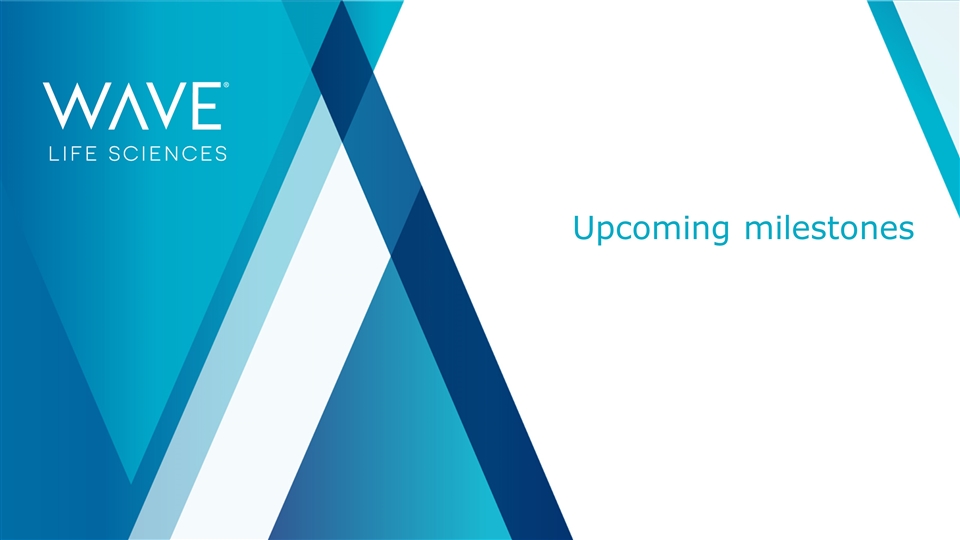
Upcoming milestones
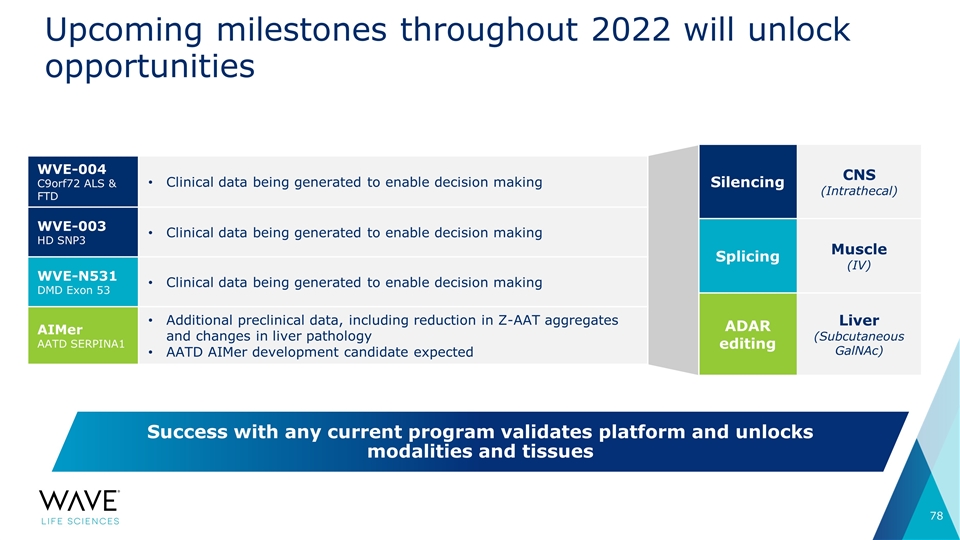
Upcoming milestones throughout 2022 will unlock opportunities Silencing CNS (Intrathecal) Splicing Muscle (IV) ADAR editing Liver (Subcutaneous GalNAc) WVE-004 C9orf72 ALS & FTD Clinical data being generated to enable decision making WVE-003 HD SNP3 Clinical data being generated to enable decision making WVE-N531 DMD Exon 53 Clinical data being generated to enable decision making AIMer AATD SERPINA1 Additional preclinical data, including reduction in Z-AAT aggregates and changes in liver pathology AATD AIMer development candidate expected Success with any current program validates platform and unlocks modalities and tissues

Realizing a brighter future for people affected by genetic diseases For more information: Kate Rausch, Investor Relations krausch@wavelifesci.com 617.949.4827














































































